We had hoped to leave for Palermo earlier than we did. We had to wait for a repaired battery charger to be delivered to Seahike.
To be perfectly honest, though, we probably needed the break. We had come down with something (we later learned it was Covid) during our trip to Venice and Cinque Terre. My theory is that we picked it up on the train from Venice to Cinque Terre. At any rate, we were both tired and wouldn’t have wanted to make an overnight sail. Sometimes the stars align in really weird ways!
We left about 30 seconds after the package was delivered to Seahike on October 10. We were able to sail a bit, but we motored most of the way. We arrived in Palermo on October 11. Here are some pictures of our arrival in Palermo. I also want to call out Sitimar Marina. It was wonderful and the staff members were SO helpful!!!
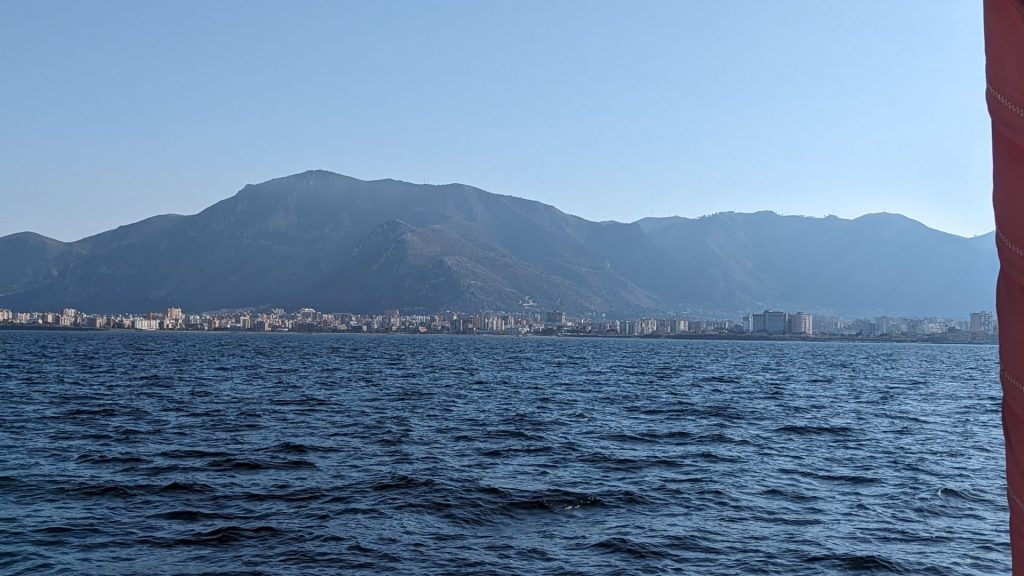
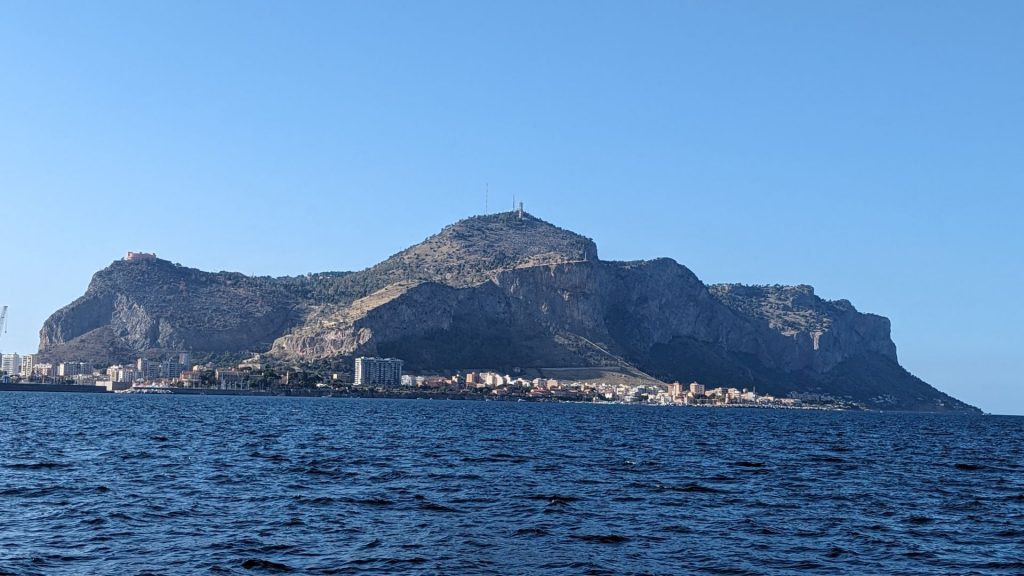
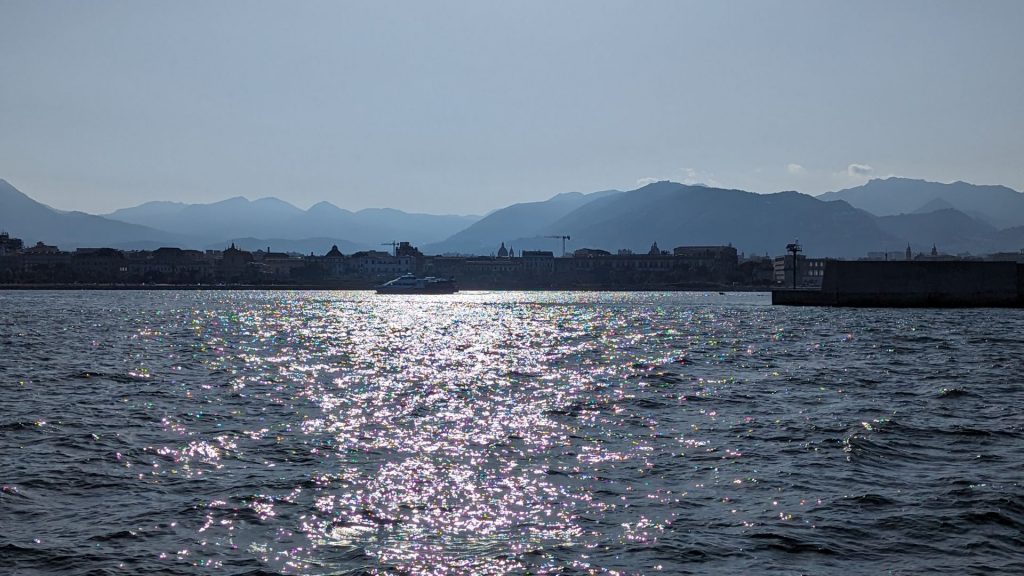
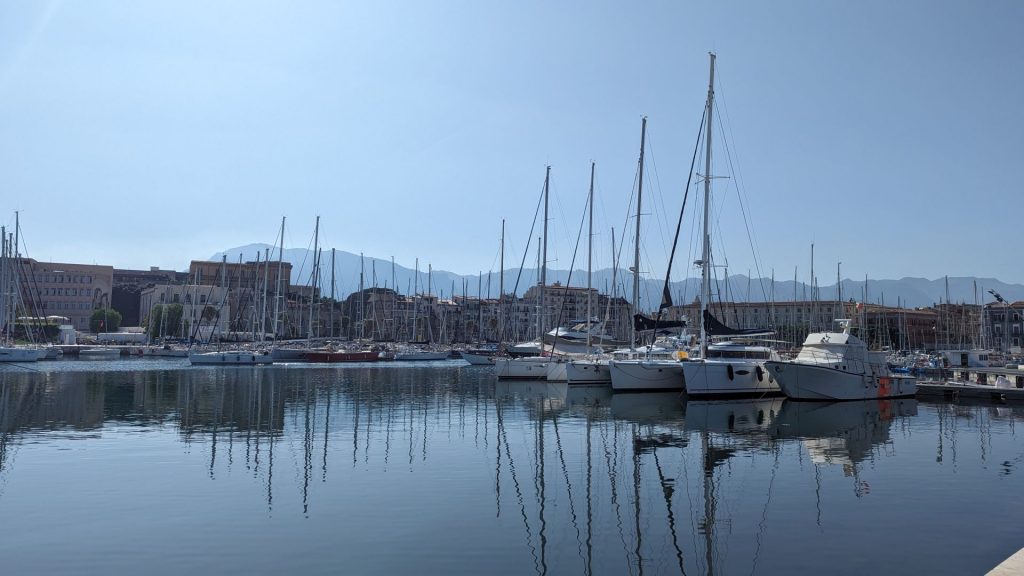
We took it easy on our first day in Palermo. I used the time to plan our sightseeing tour for the following day. Michael had to wait for the new freezer/fridge to be delivered the next day, so we didn’t know when he would be able to join me. It turned out that he was never able to join me because the freezer/fridge wasn’t delivered until late afternoon. So I will share my solo experiences with you.
I’ve read that some people don’t like Palermo. I think those people are simply looking for a different experience than Palermo offers. First, it is important to know that it is a big city. It is nothing like the small towns along the Amalfi Coast. If that is what you are seeking. . . . well, you won’t find it in Palermo. What you will find is history and numerous buildings with stunning interiors. If you are so inclined, you can even visit the catacombs. I thoroughly enjoyed my visit.
A very small bit of info about Palermo: Palermo is the capital of both the autonomous region of Sicily and the Metropolitan City of Palermo, the city’s surrounding metropolitan province. It is noted for its history, culture, architecture and gastronomy, playing an important role throughout much of its existence; it is over 2,700 years old.
I chose several places to visit, yet I saw only a small portion of the city. I still managed to take more than 17,000 steps, so I think I did okay for a one-day visit.
My first stop was an epic fail. I wanted to visit the Massimo Theater, but when I arrived where Google maps told me to go, there was nothing there. I asked a few people, but they didn’t know what I was talking about. That was unfortunate. So, I went to my next stop, one of the markets for which the city is famous: Mercado del Capo. I didn’t buy anything because I had no appetite, but I enjoyed the market and all of the displays!
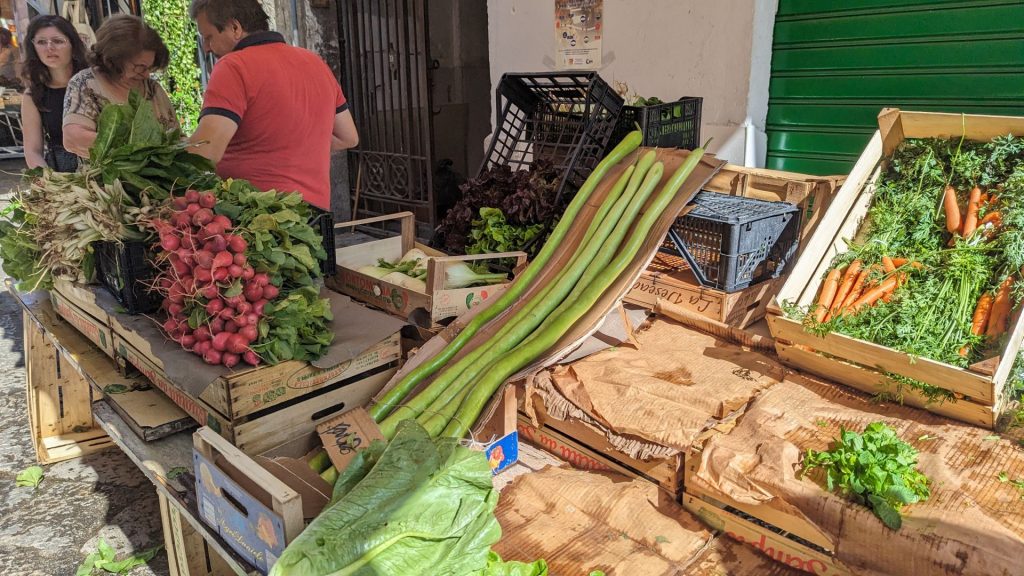
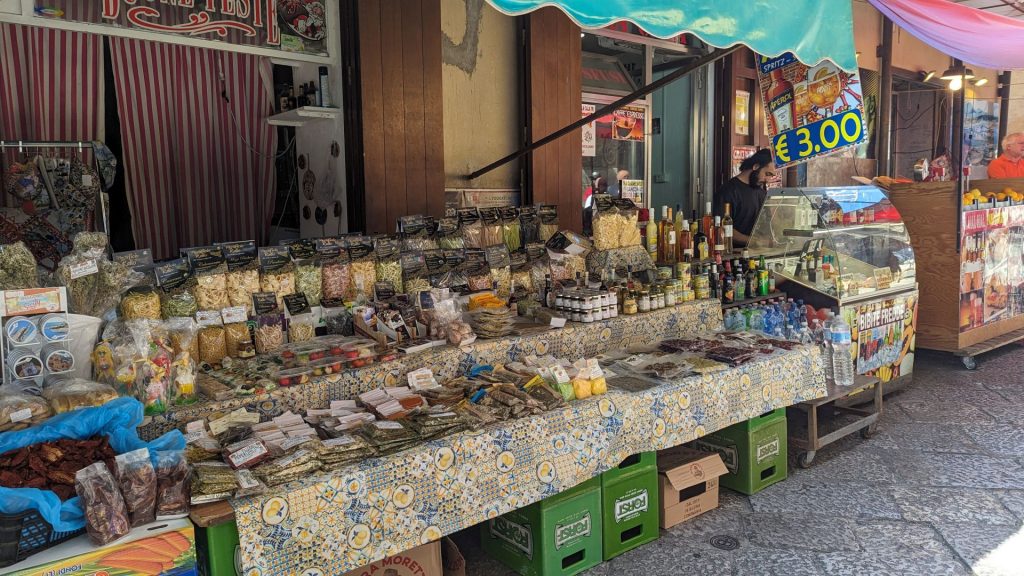
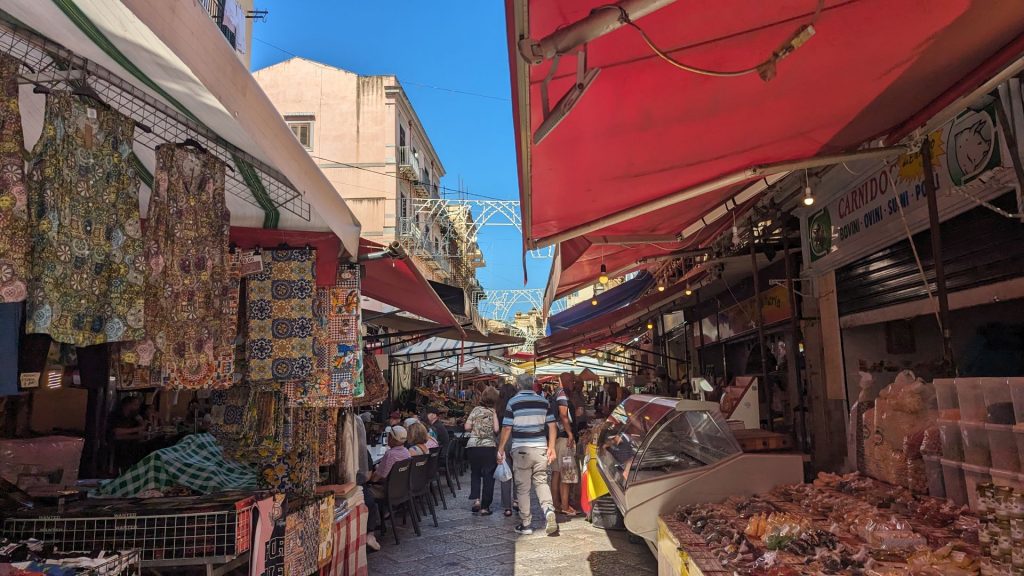
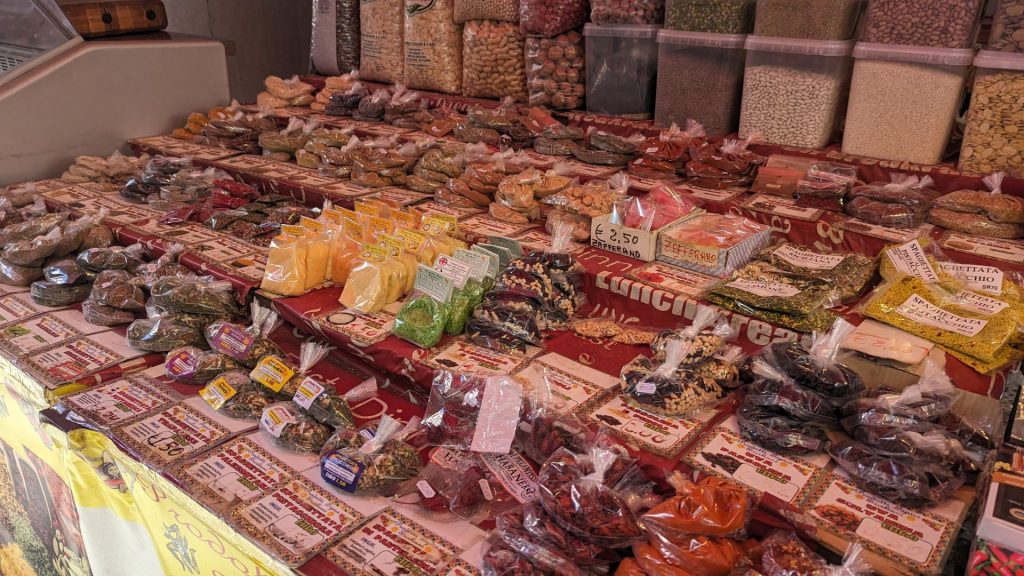
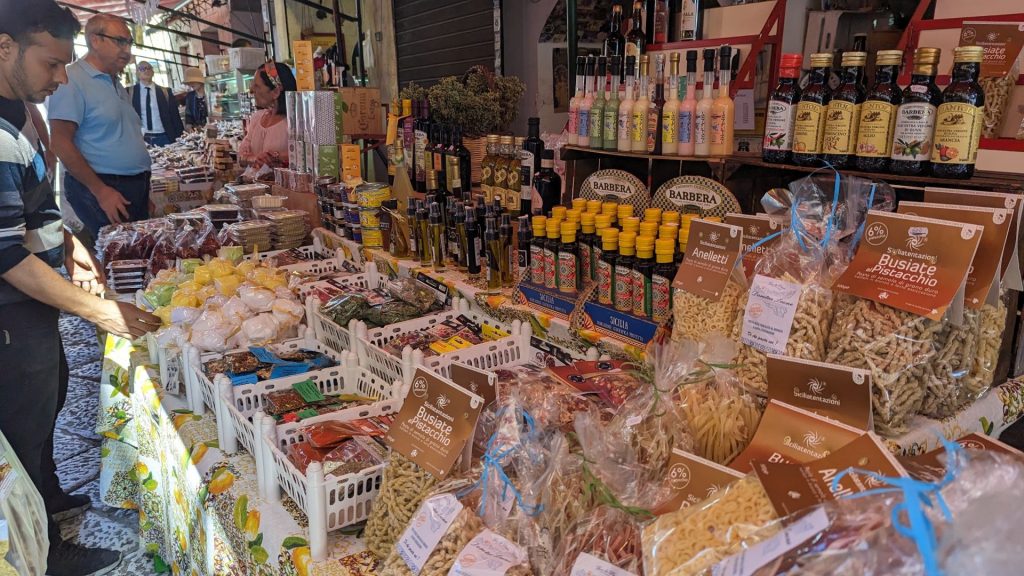
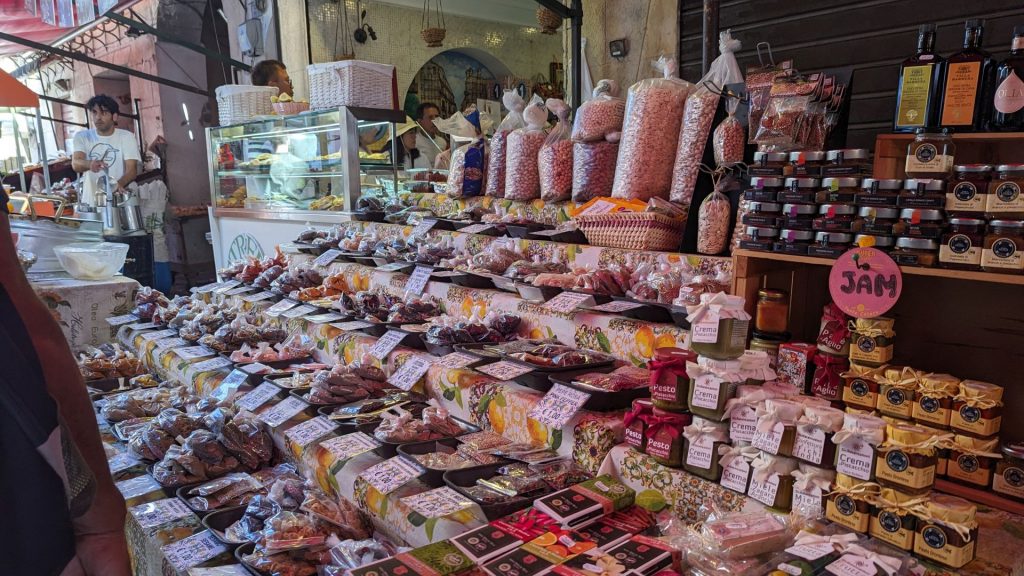
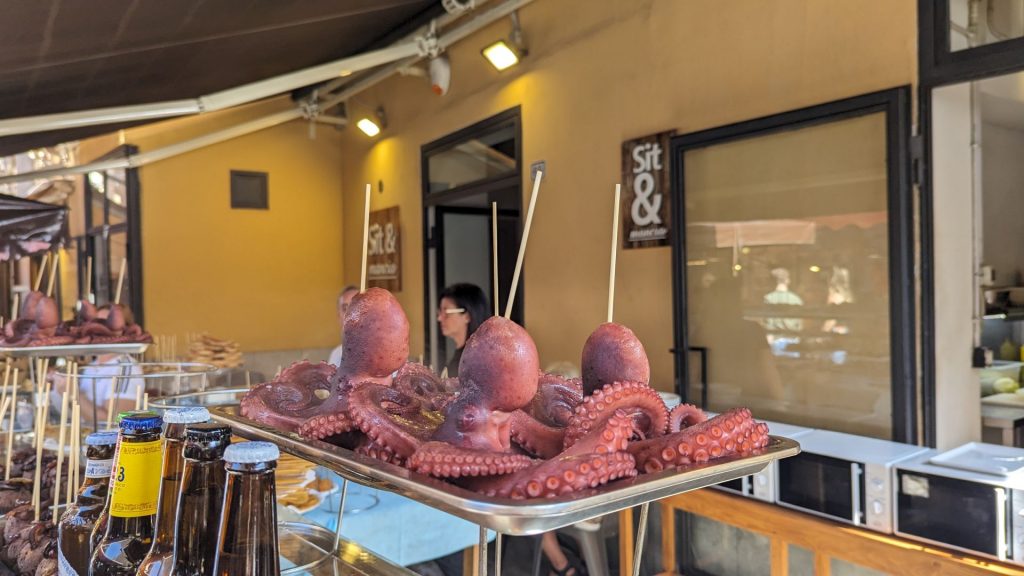
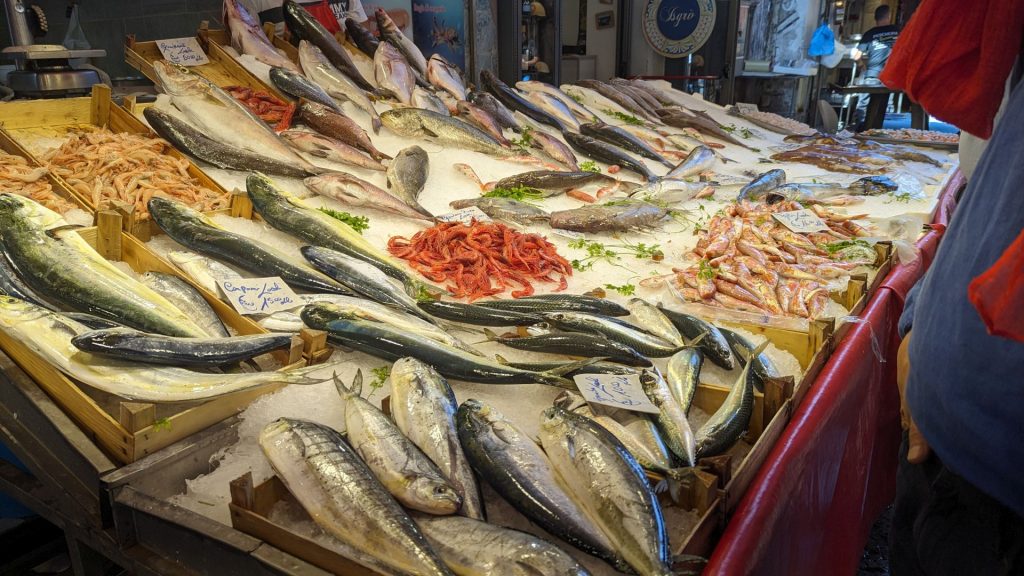
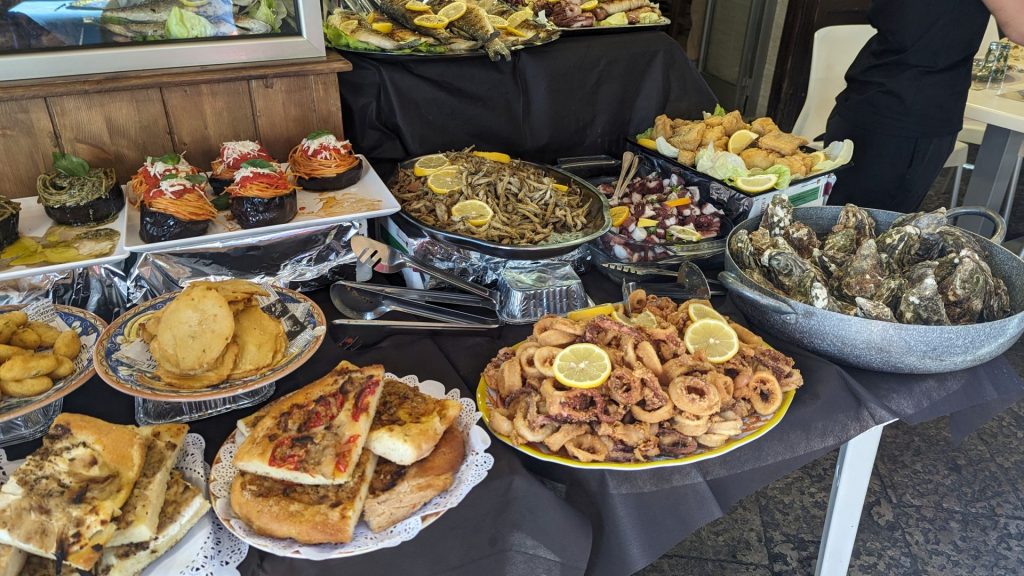
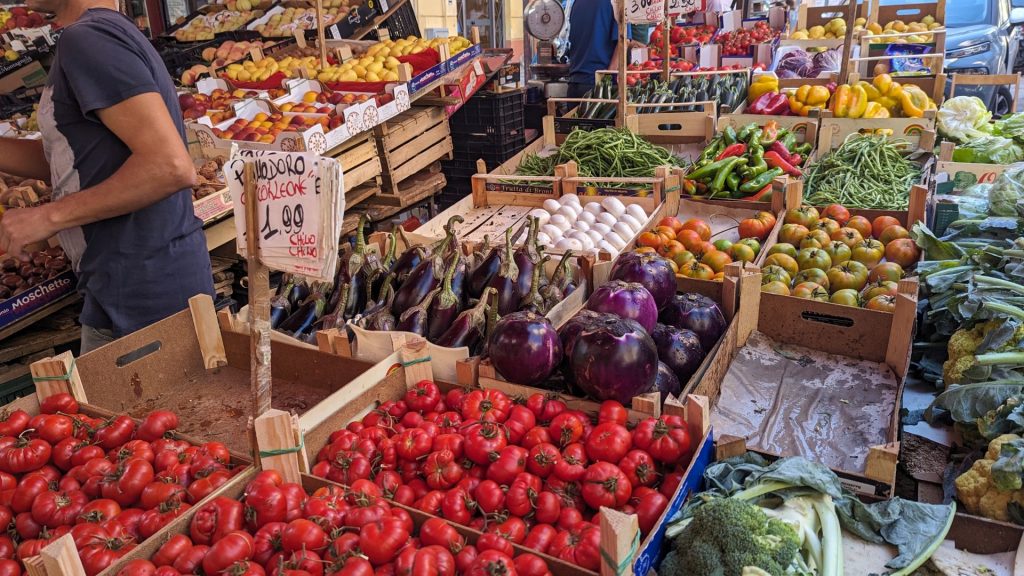
It was time to go to the Palermo Cathedral. But first, a few pictures of Palermo and the street art/graffiti.
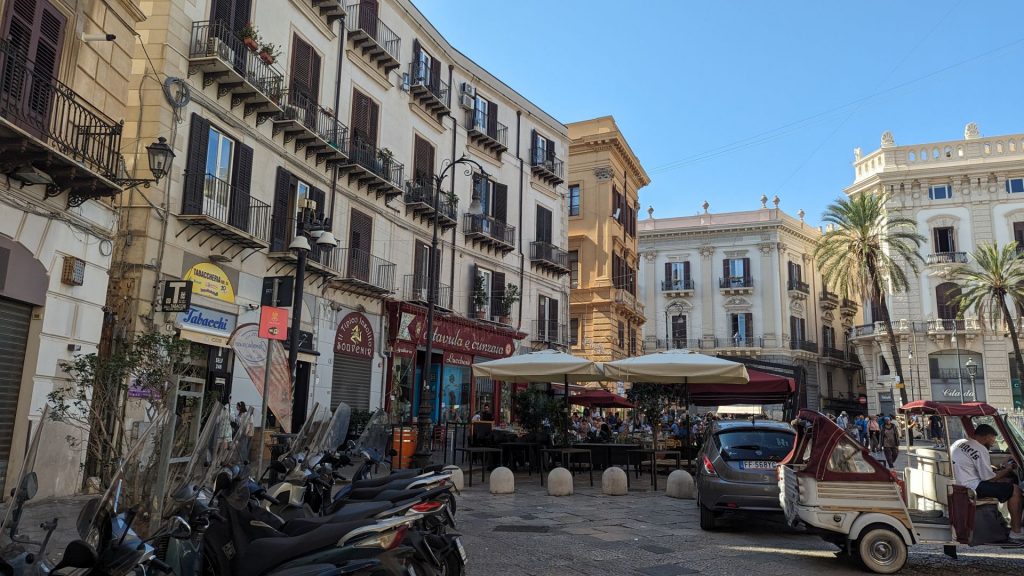
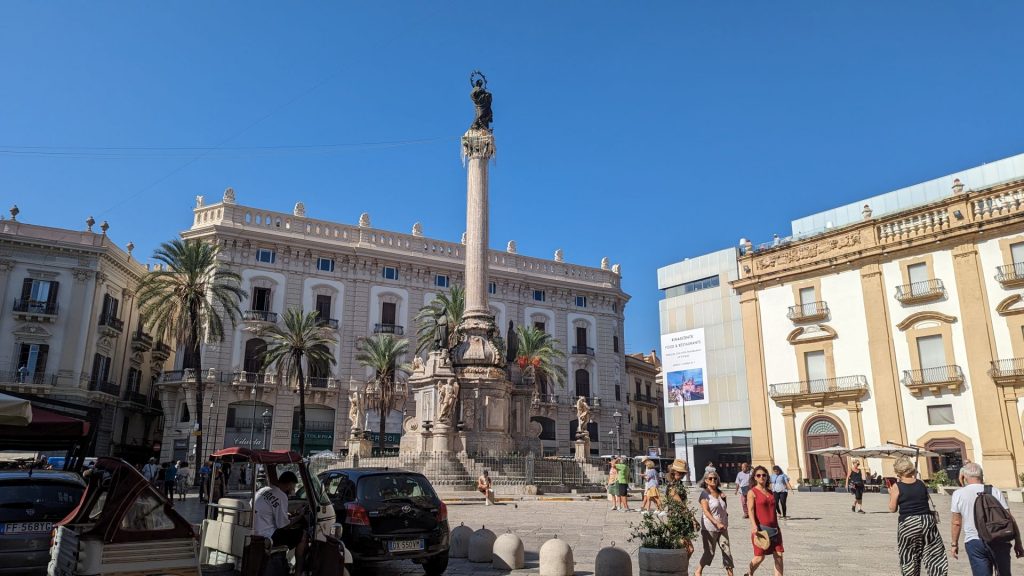
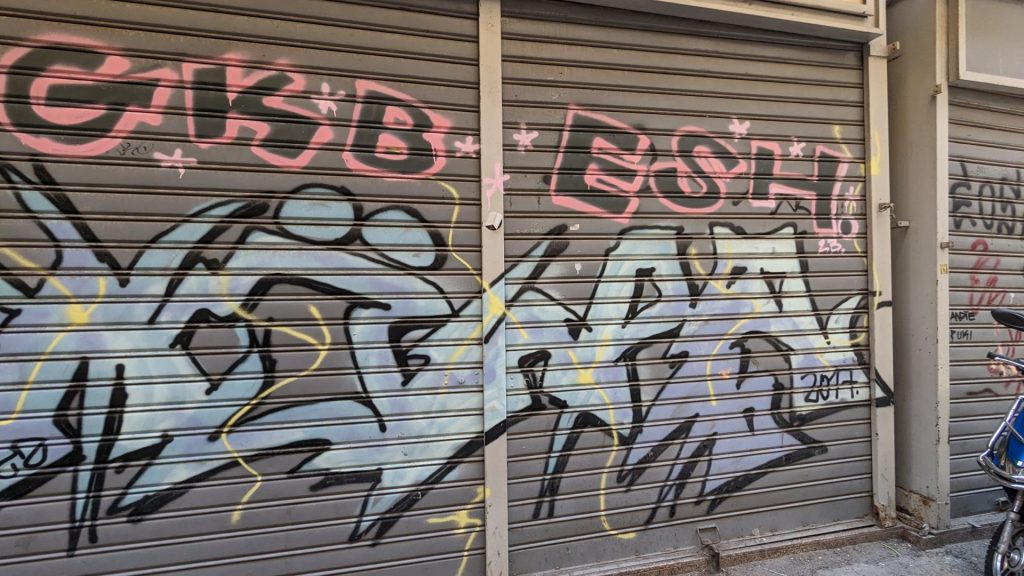
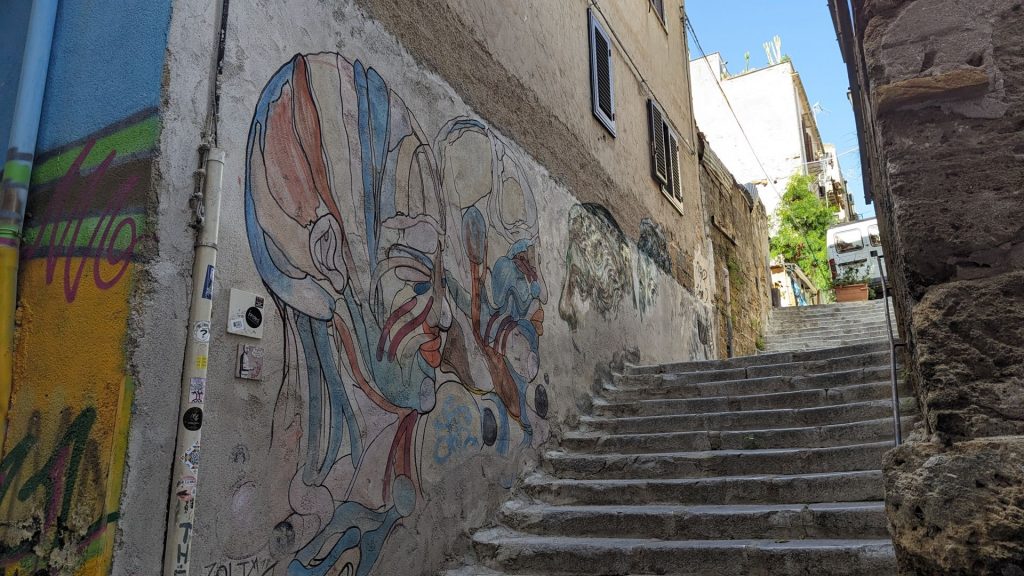
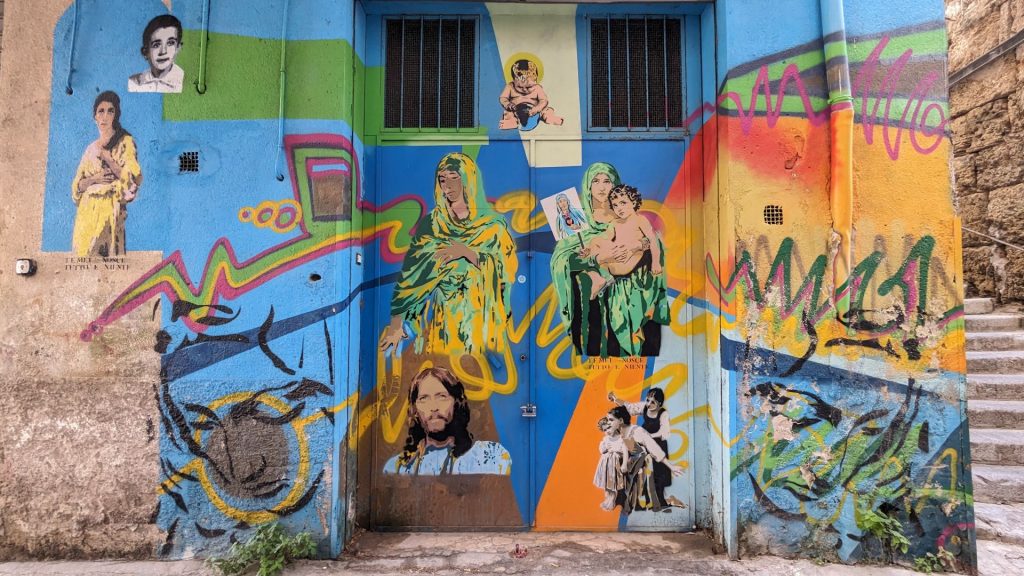
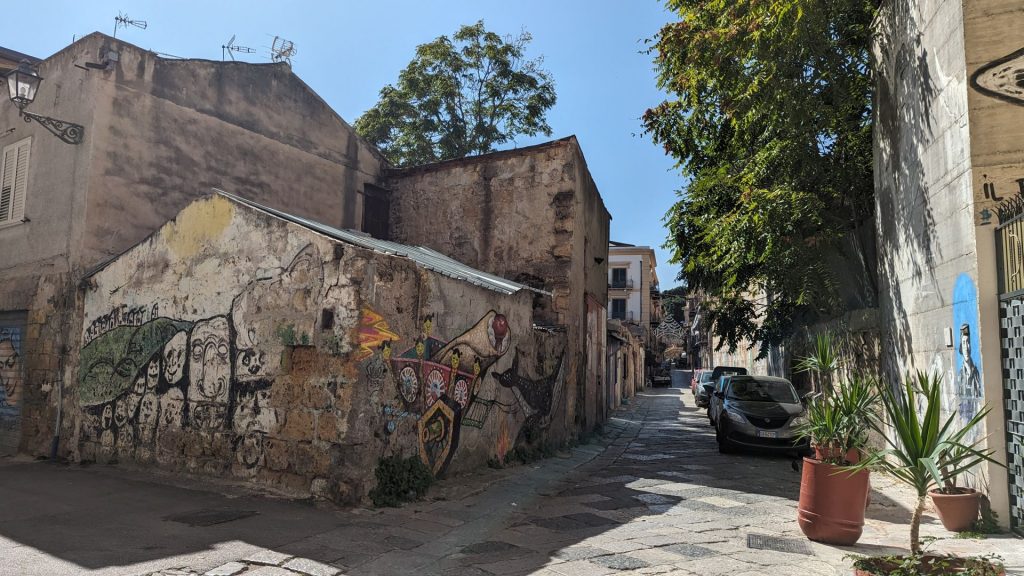
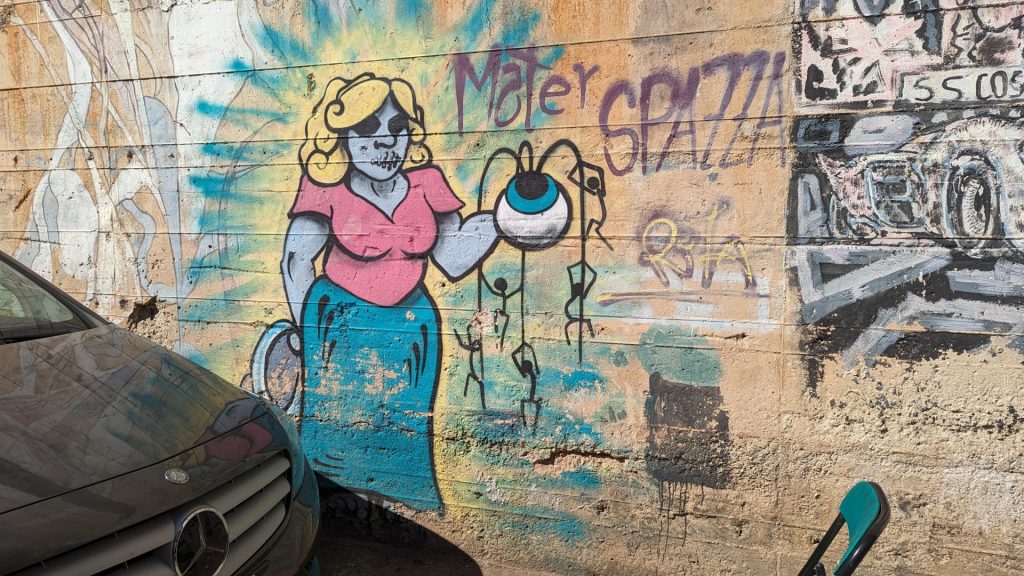
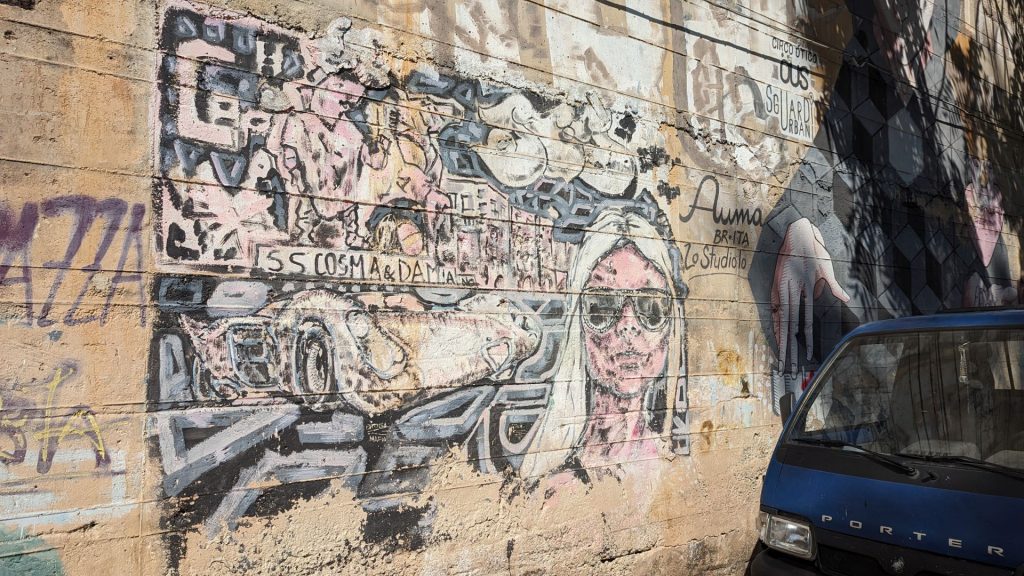
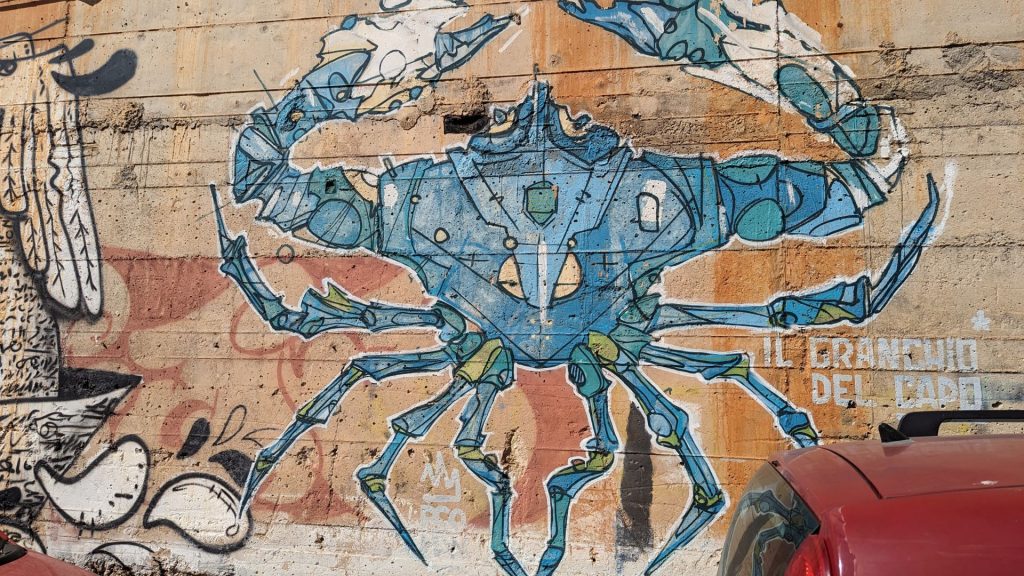
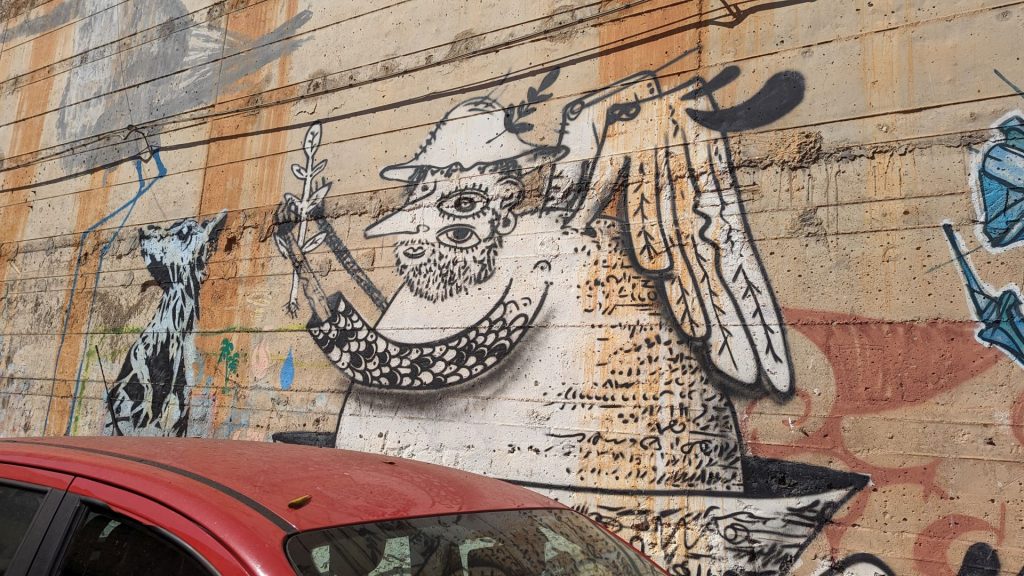
My favorite part of the Palermo Cathedral was the view from the roof, but the interior was also nice. Palermo Cathedral is the cathedral church of the Roman Catholic Archdiocese of Palermo. It is dedicated to the Assumption of the Virgin Mary. As an architectural complex, it is characterized by the presence of different styles, due to a long history of additions, alterations and restorations, the last of which occurred in the 18th century.
The church was erected in 1185 by Walter Ophamil, the Norman archbishop of Palermo and King William II’s minister, on the site of an earlier Byzantine basilica. By all accounts this earlier church was founded by Pope Gregory I and was later turned into a mosque by the Saracens after their conquest of the city in the 9th century. Ophamil is buried in a sarcophagus in the church’s crypt.
The upper orders of the corner towers were built between the 14th and the 15th centuries, while in the early Renaissance period the southern porch was added. The present neoclassical appearance dates from the work carried out over the two decades 1781 to 1801.
Here are a couple of views of the front and several from the roof.
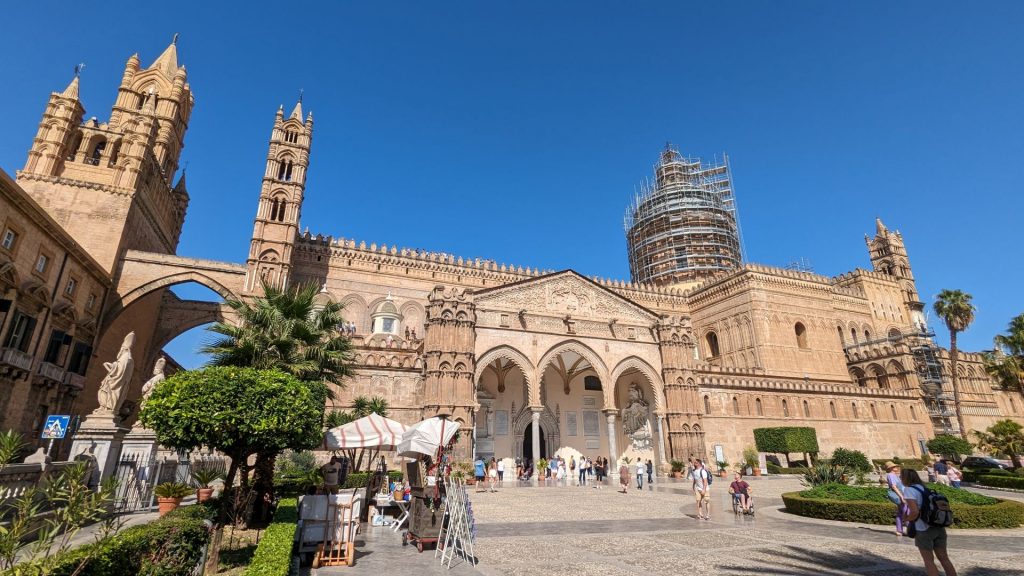
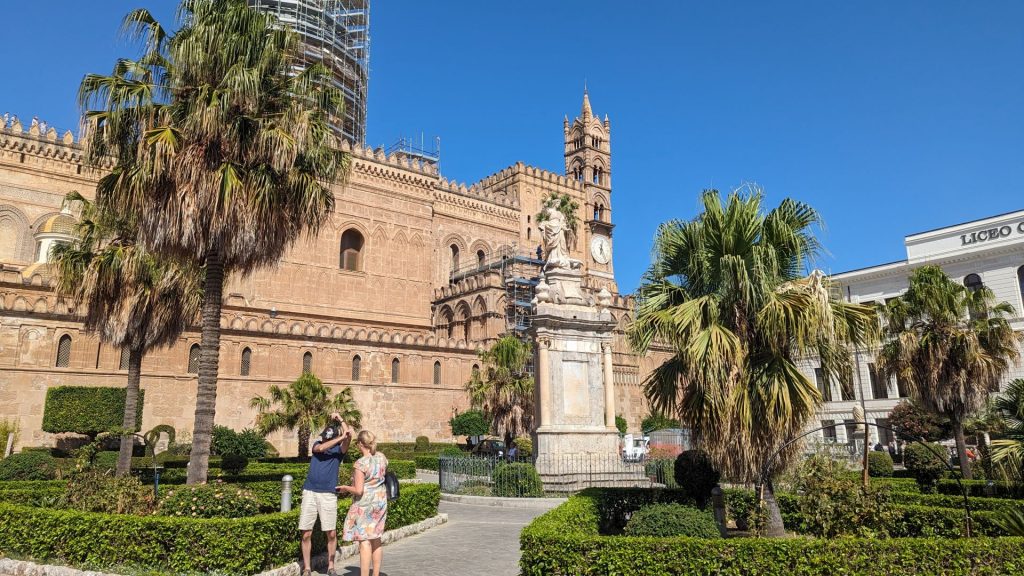
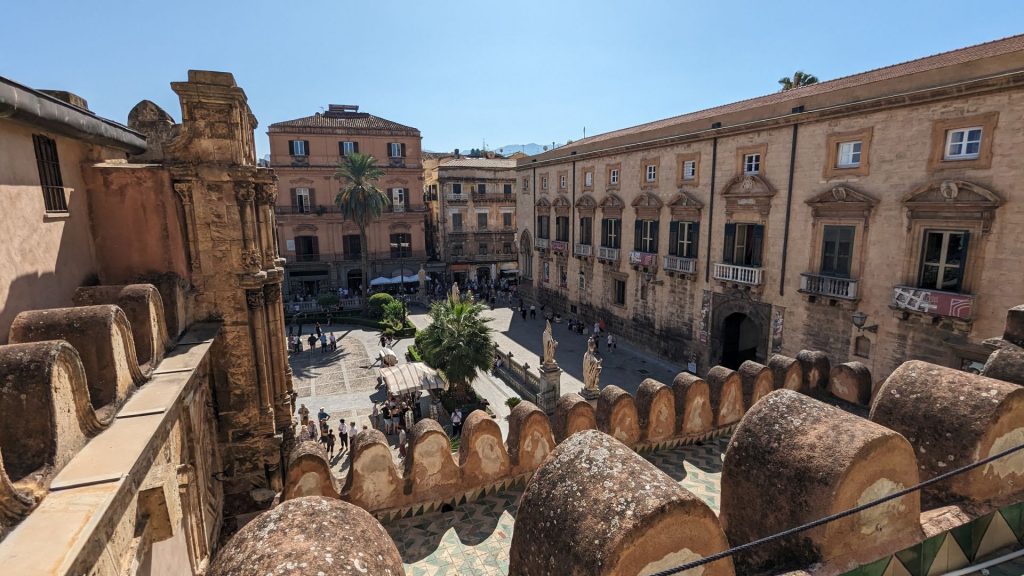
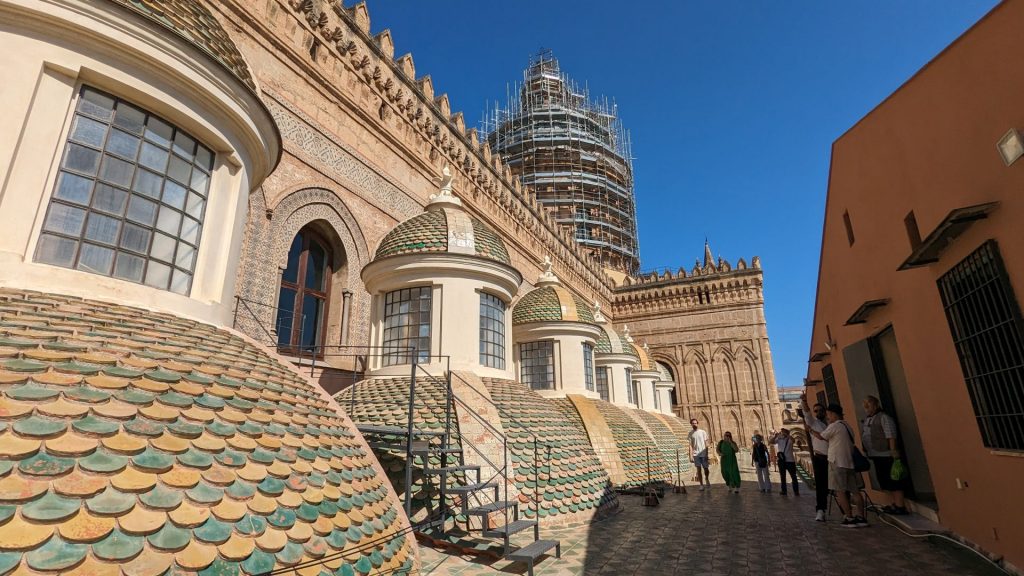
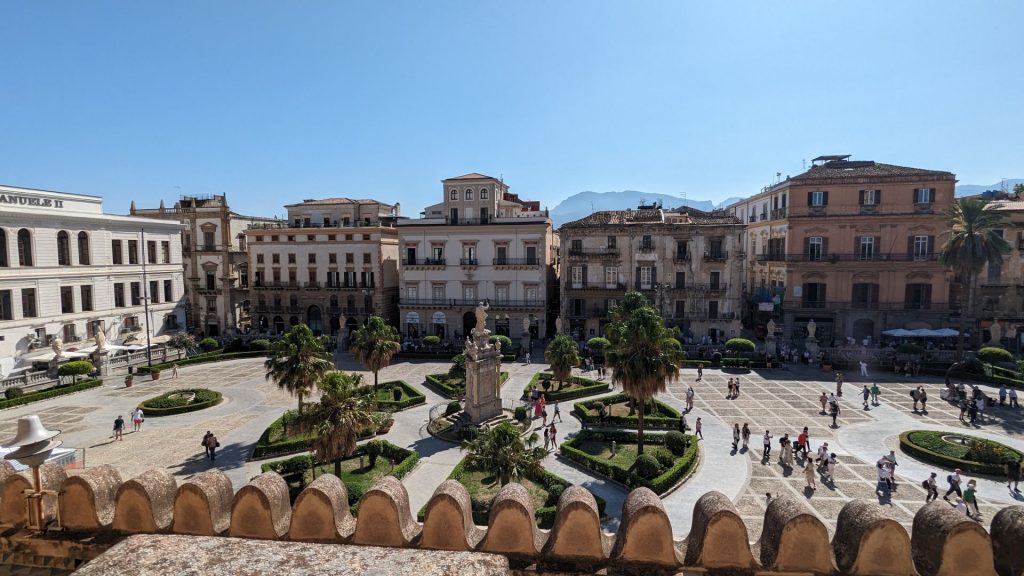
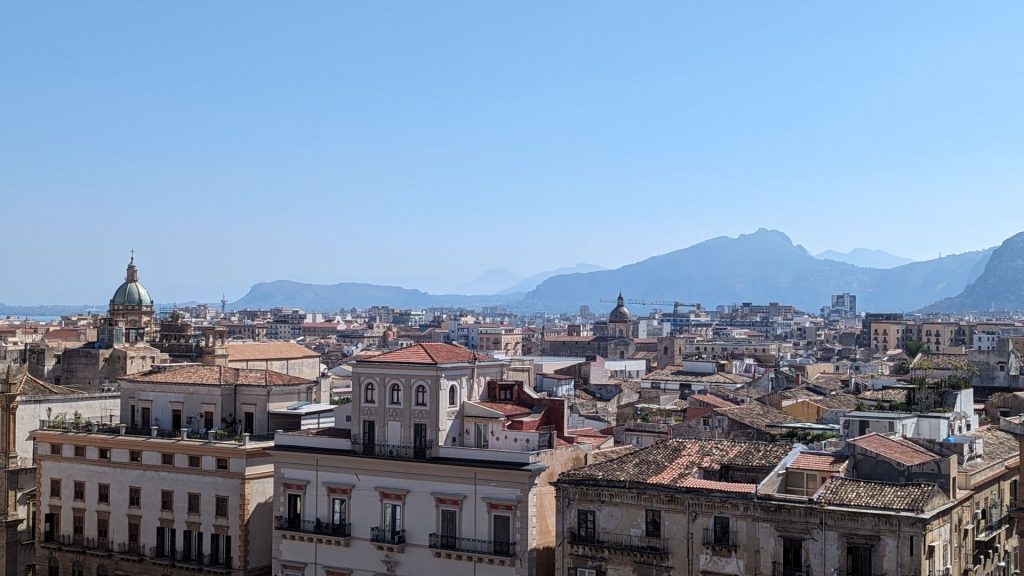
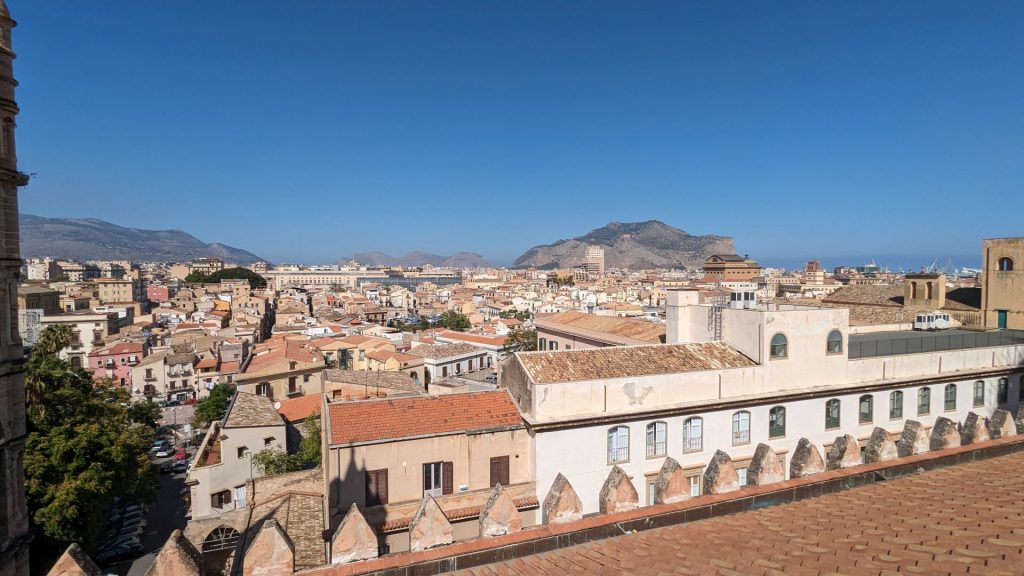
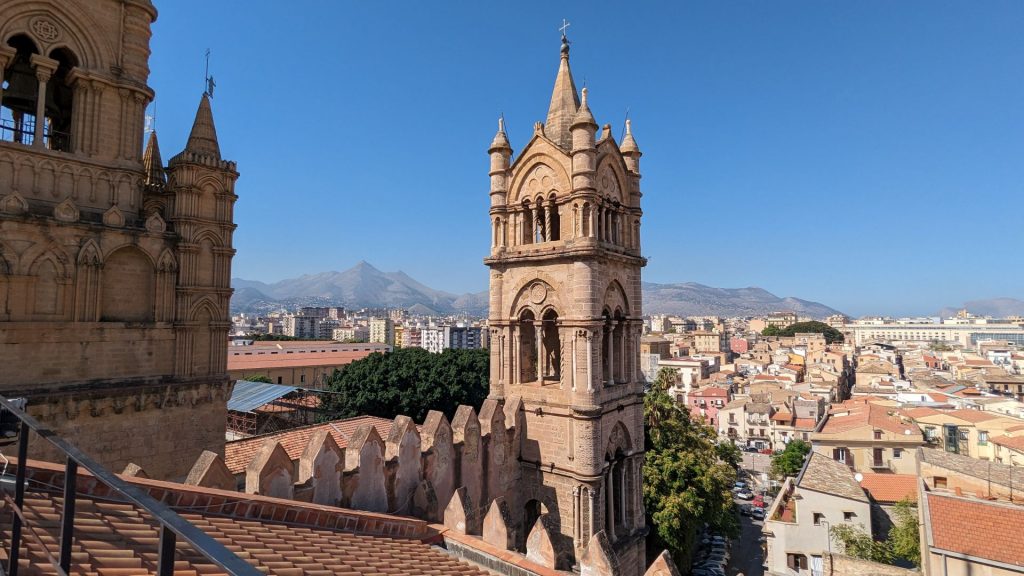
The royal tombs. The first picture is of the sarcophagus of Emperor Frederick II of Hohenstaufen. Frederick II was King of Sicily from 1198, King of Germany from 1212, King of Italy and Holy Roman Emperor from 1220 and King of Jerusalem from 1225. When in Sicily, he reorganized the kingdom and brought it under tight control, establishing peace in the realm.
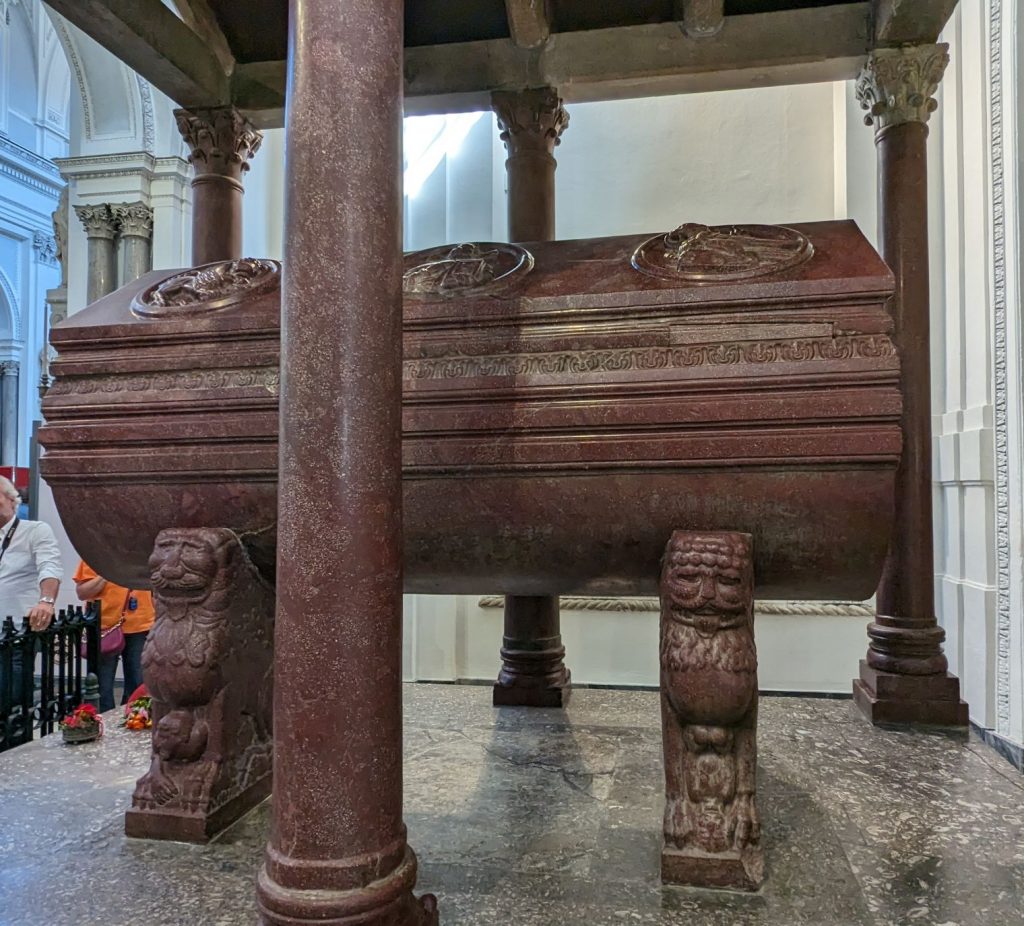
I also saw Henry VI’s (1165 – 1197) sarcophagus. Henry VI, a member of the Hohenstaufen dynasty, was King of Germany (King of the Romans) from 1169 and Holy Roman Emperor from 1191 until his death. From 1194 he was also King of Sicily. Well educated in the Latin language, as well as Roman and canon law, Henry was also a patron of poets and a skilled poet himself.
Costanza d’Altavilla’s (Henry VI’s wife, and Frederick II’s mother) sarcophagus was located nearby, as was the tomb of another bigwig: King Roger II. Roger II or Roger the Great was King of Sicily and Africa, son of Roger I of Sicily and successor to his brother Simon. He began his rule as Count of Sicily in 1105, became Duke of Apulia and Calabria in 1127, then King of Sicily in 1130 and King of Africa in 1148.
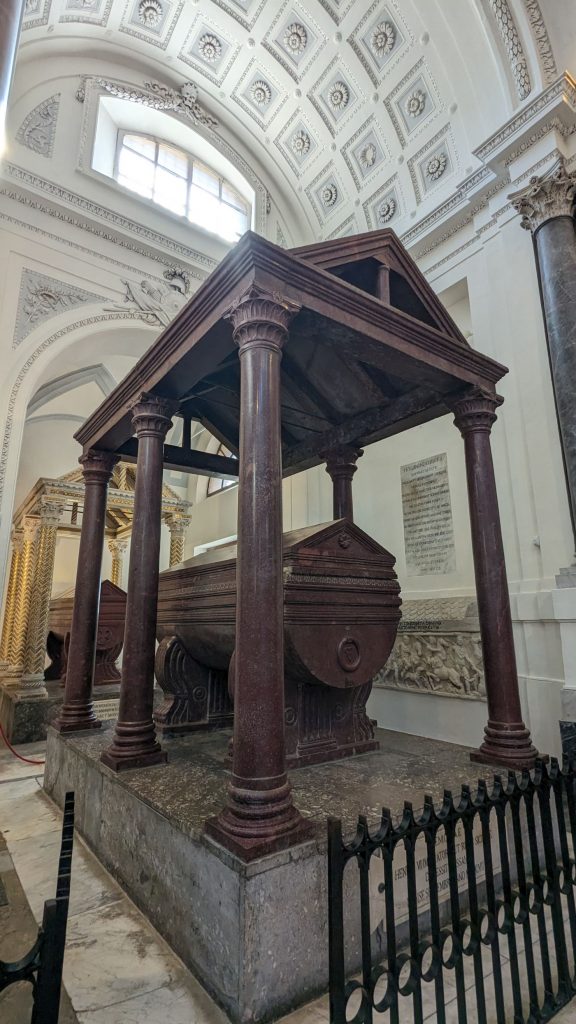
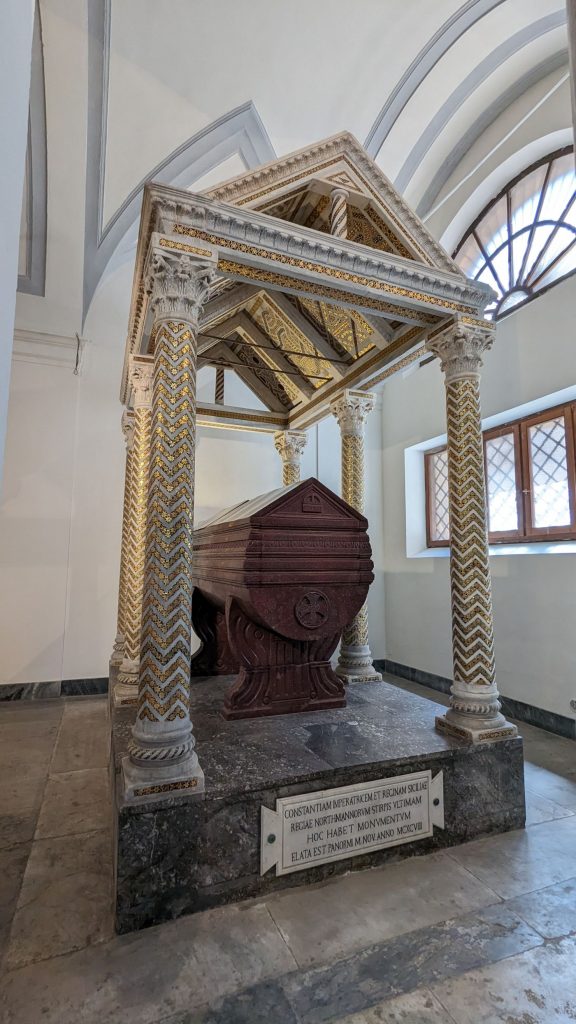
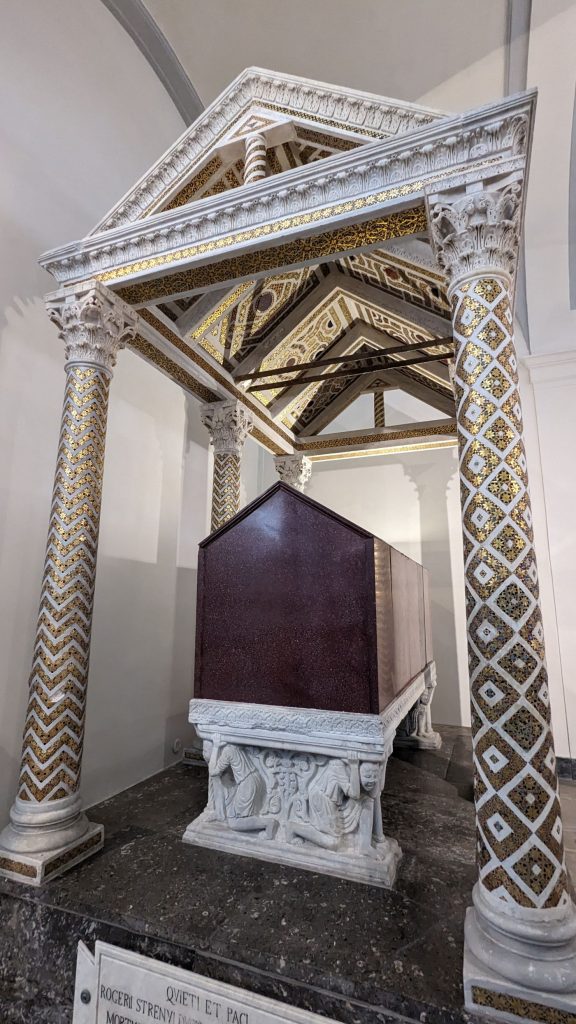
Here are some pictures of the interior of the cathedral.
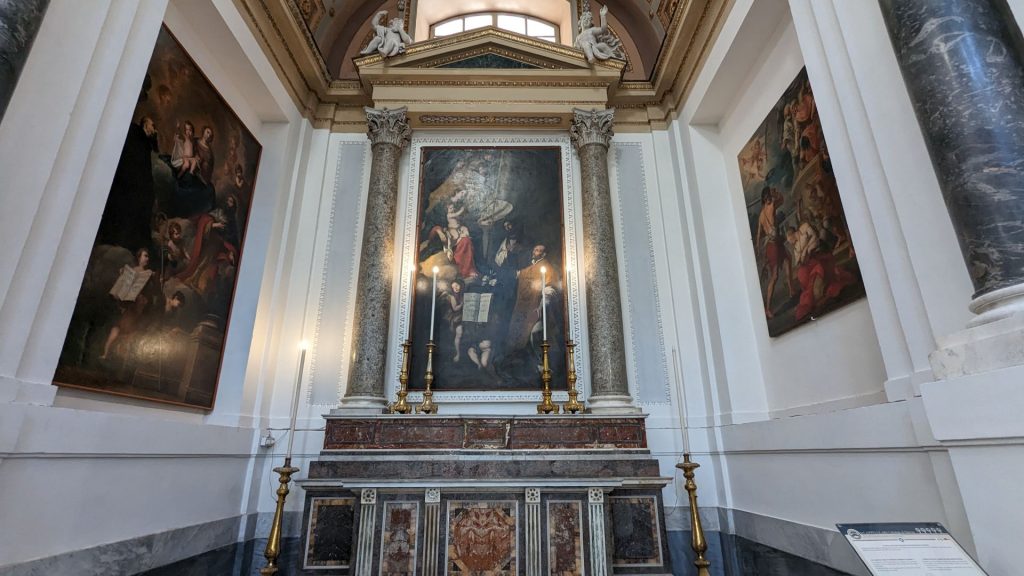
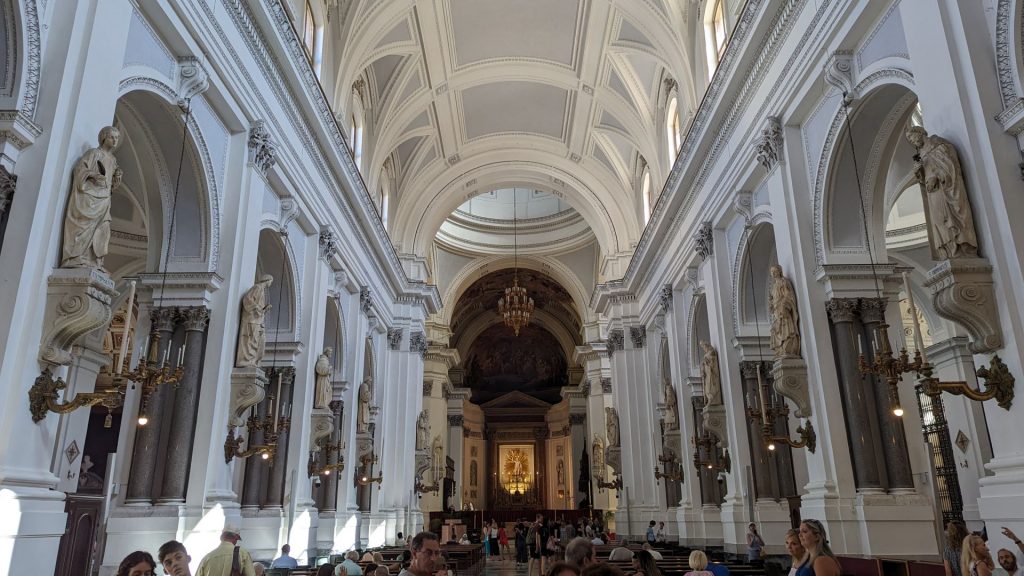
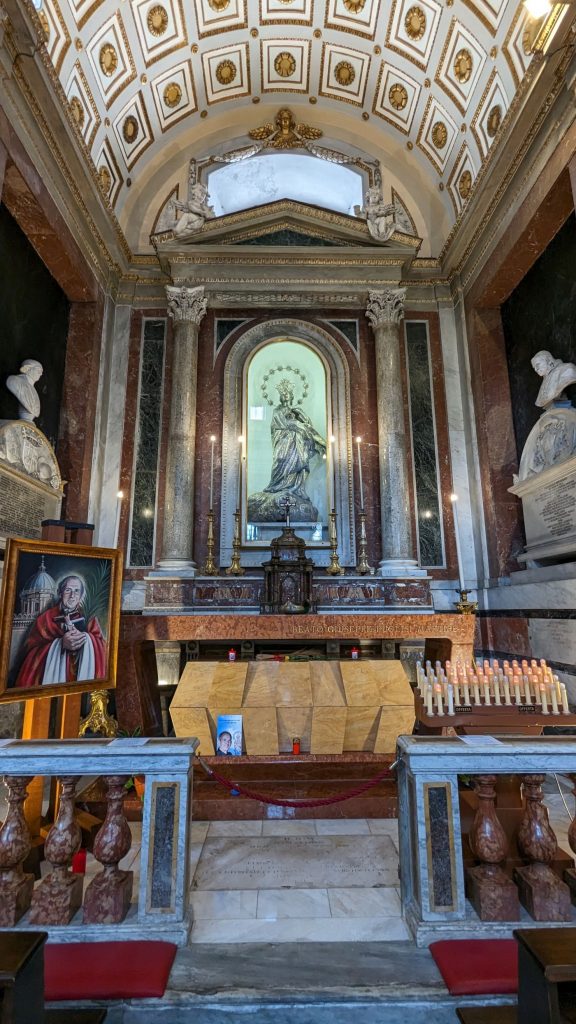
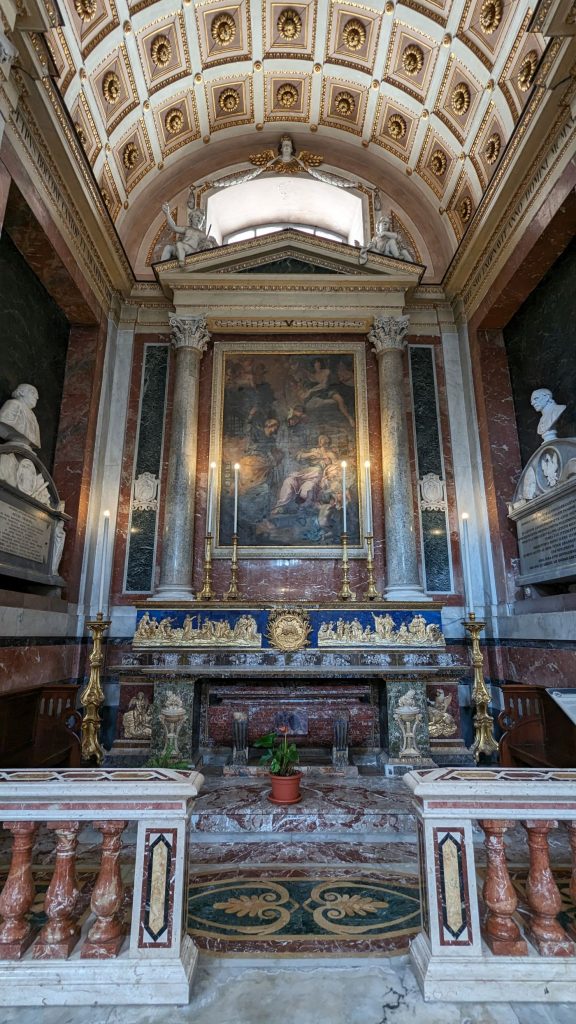
The next stop was the Diocesan Museum of Palermo, a museum of religious art, housed in a number of rooms in the Palazzo Arcivescovile. It is an historic building of the 15th century, with frescoes and furnishings of the 18th and 19th centuries. It displays around 300 works of art from the 12th to the 19th century in 27 rooms. Twelve rooms belong to “Le Stanze dei Vescovi,” the noble floor of the Archbishop’s Palace, with the Alcova of Cardinal Gravina, the Green, the Red, the Blue and the Yellow Rooms and the Sala Borremans entirely freshly painted in 1733. I was repeatedly amazed by the beauty of the artwork and rooms. Here are just a handful of pictures.
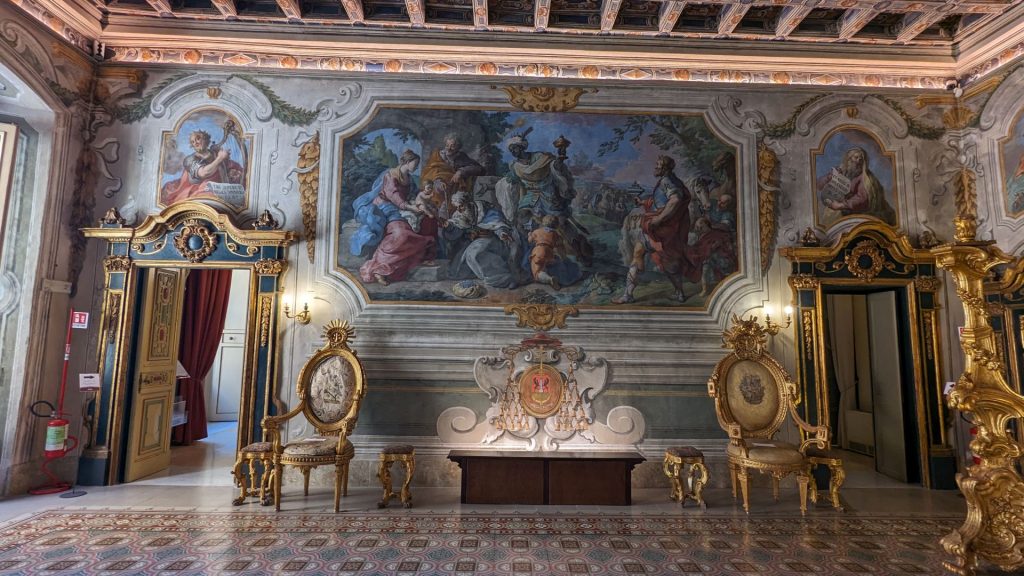
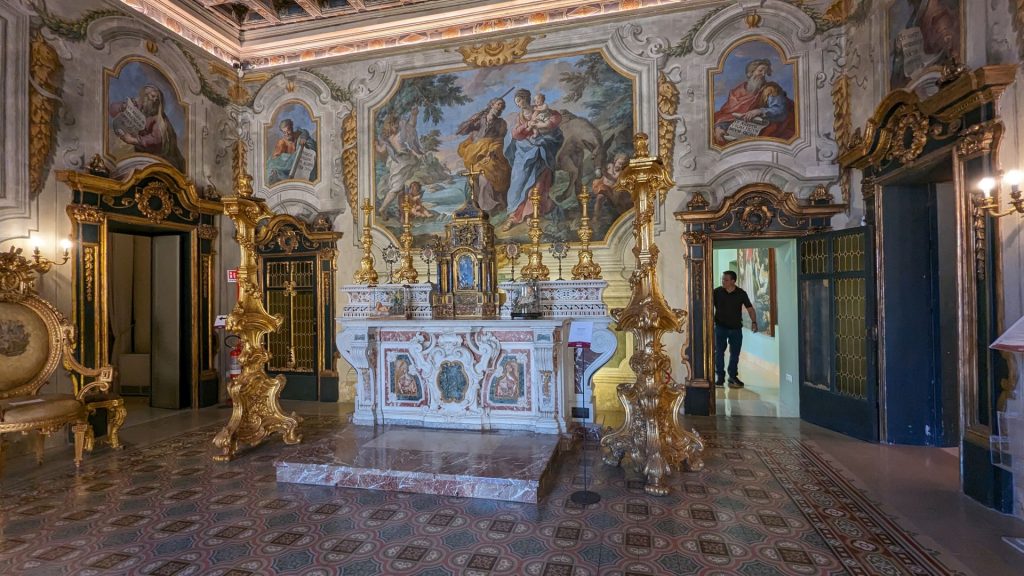
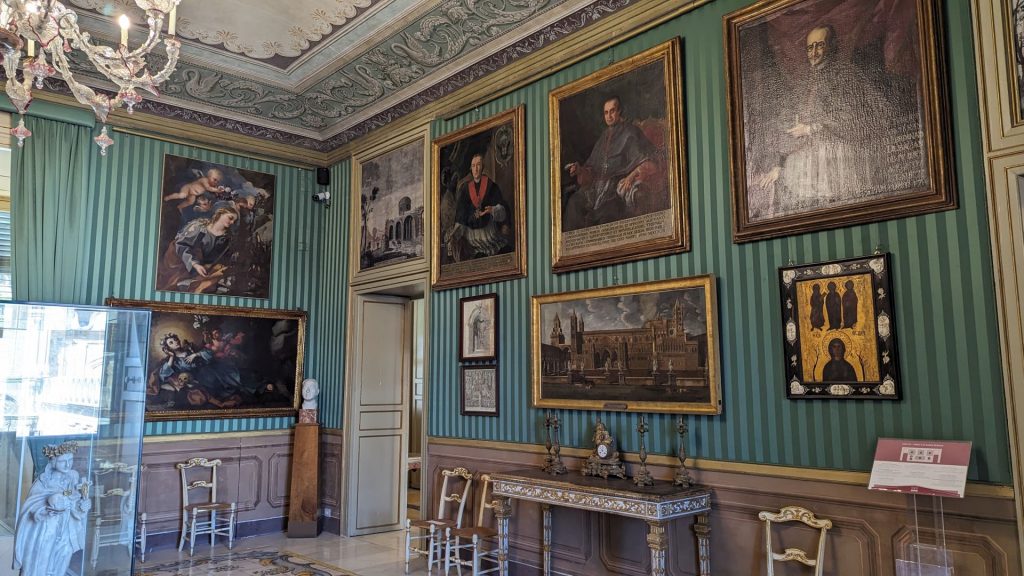
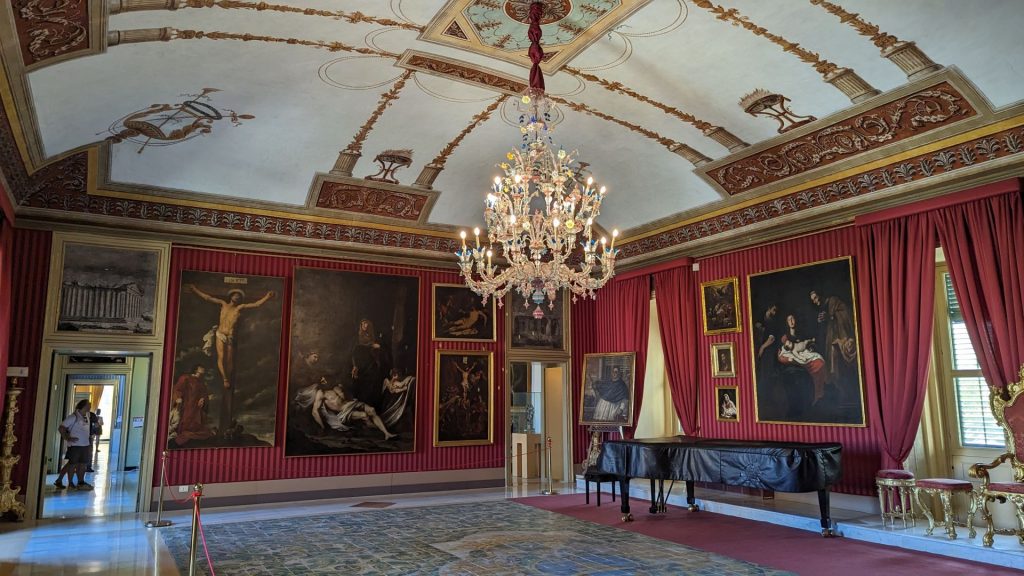
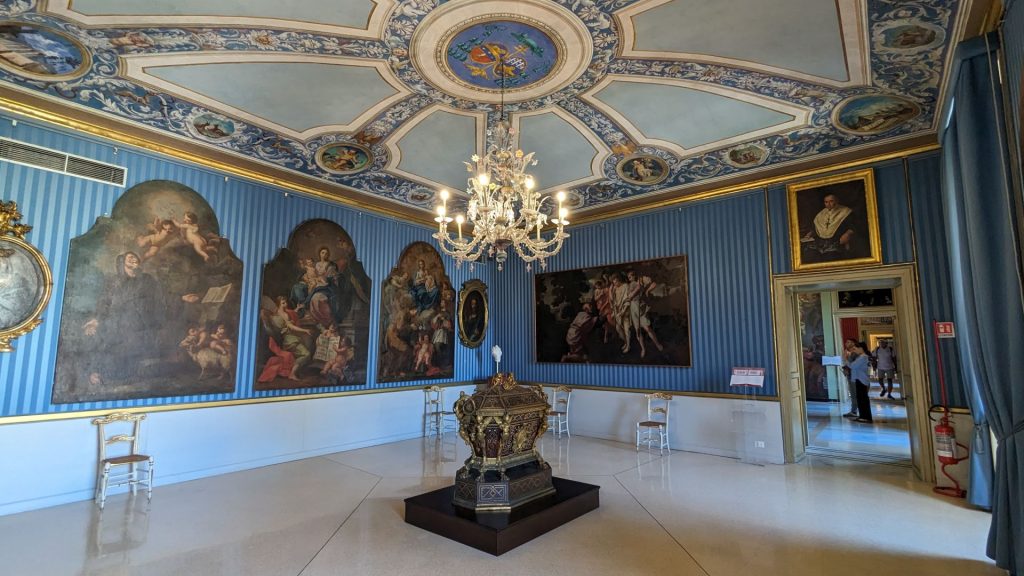
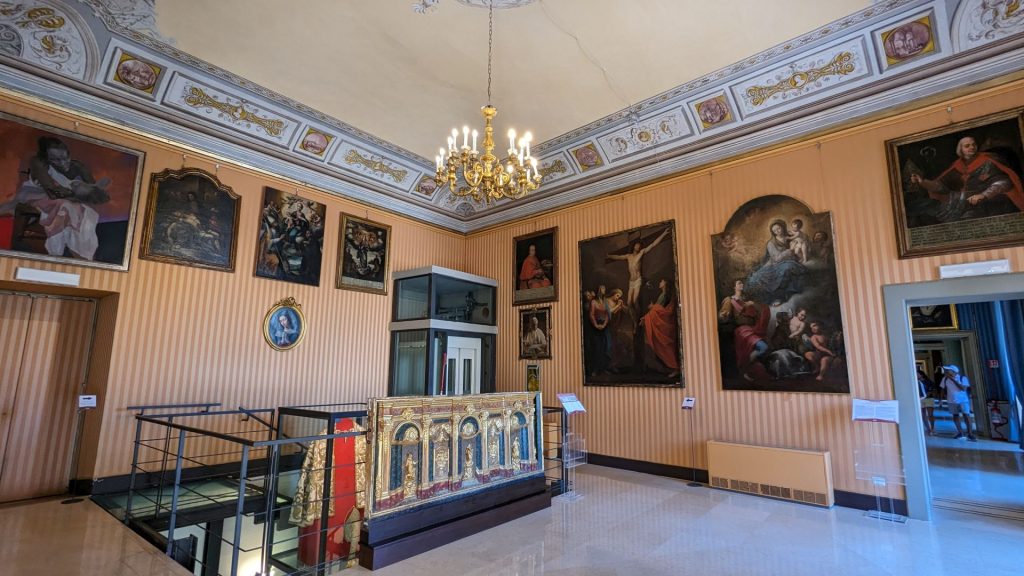
I took pictures of this chap (below) primarily because I like the beings at his feet and how they are eyeballing each other. 🙂 🙂
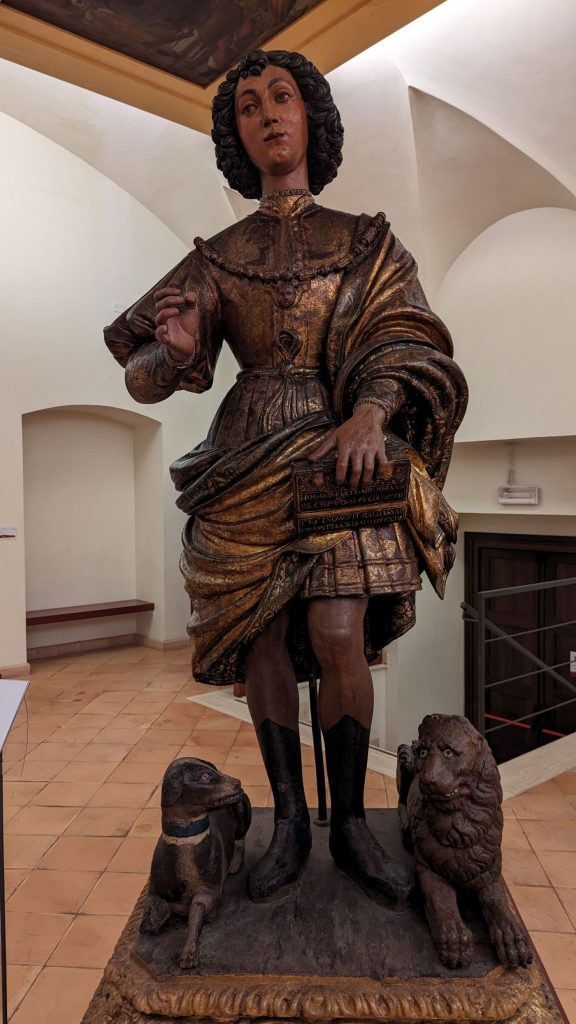
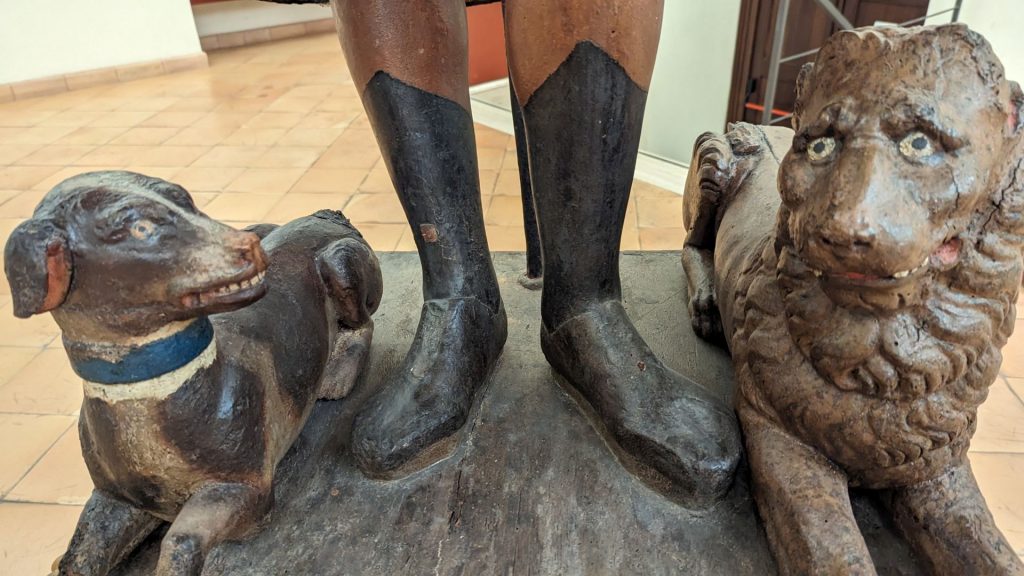
The Royal Palace and Palatine Chapel were next on my agenda. There isn’t a lot to share about the place but the chapel is fantastic! From visitsicily.info: The Palatine Chapel is a site that alone makes a visit to Palermo worthwhile. (I kind of agree with this statement.) Begun in 1130, the year of Roger II’s coronation as the first king of Sicily, it was completed in 13 years and consecrated in 1143. In this church, described by Maupassant as “the most beautiful religious jewel dreamt of by human thought,” the fusion of the vast diversity of Sicily’s origins – European, Sicilian, Byzantine and Arab – is realized in visual terms.
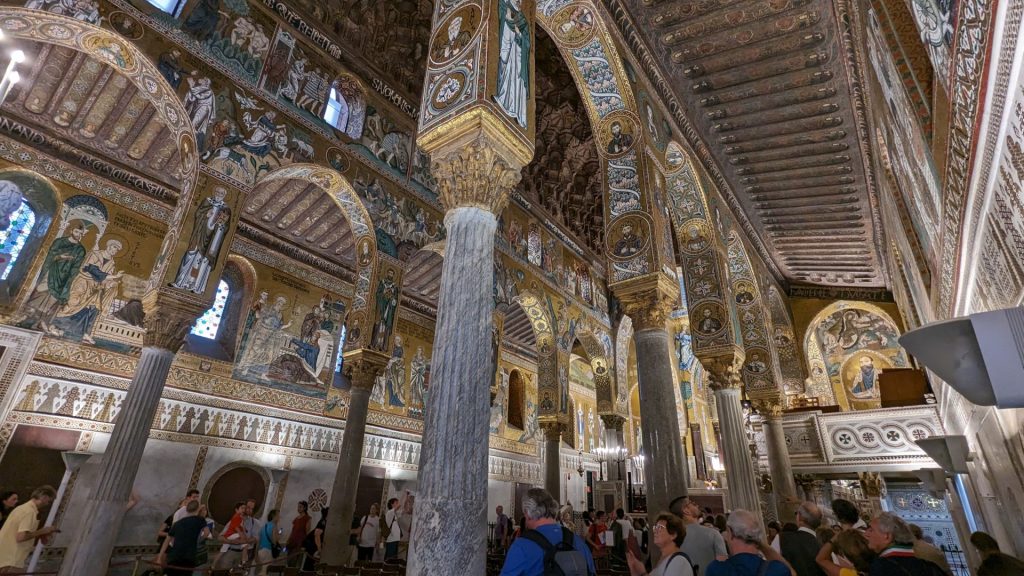
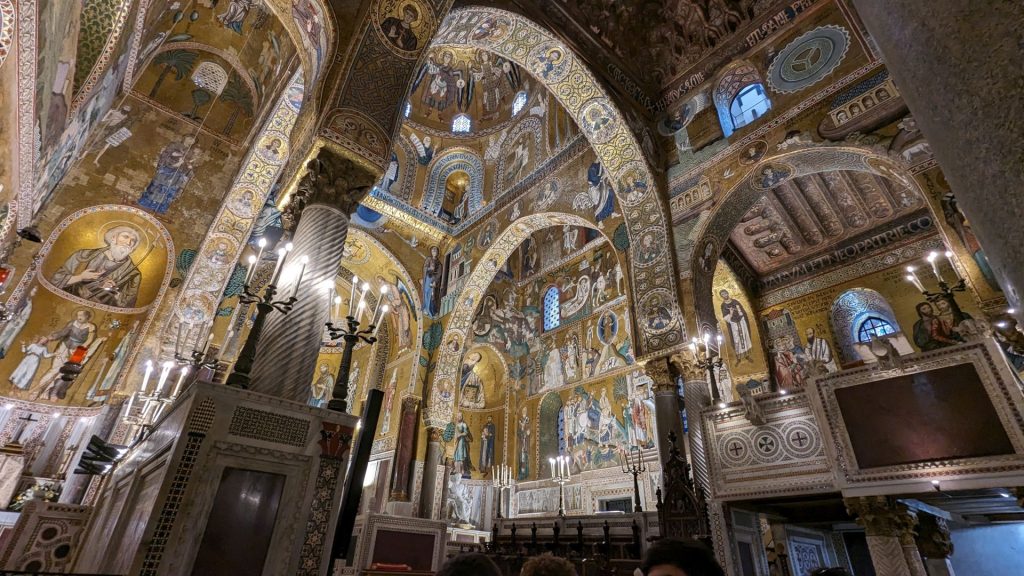
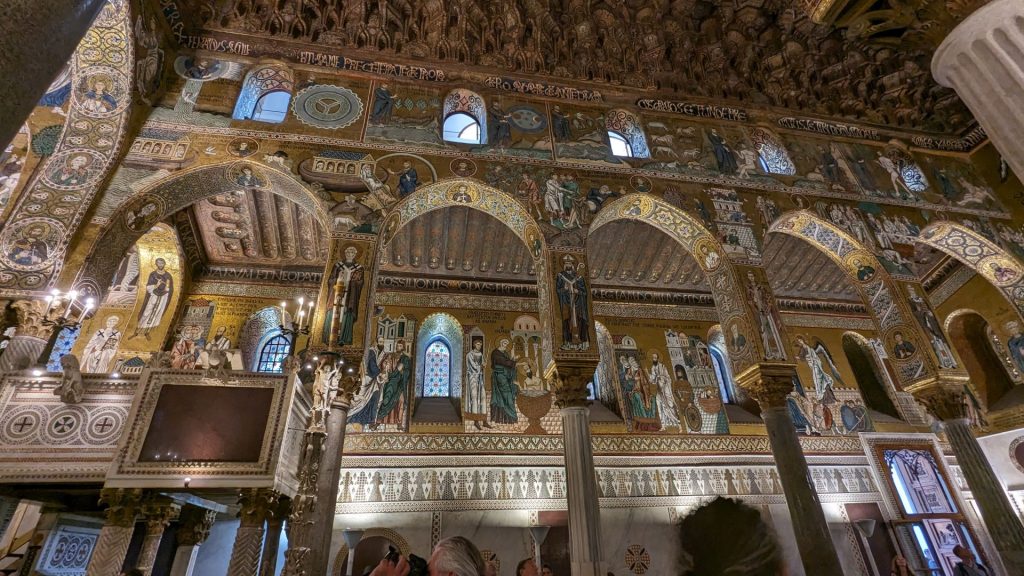
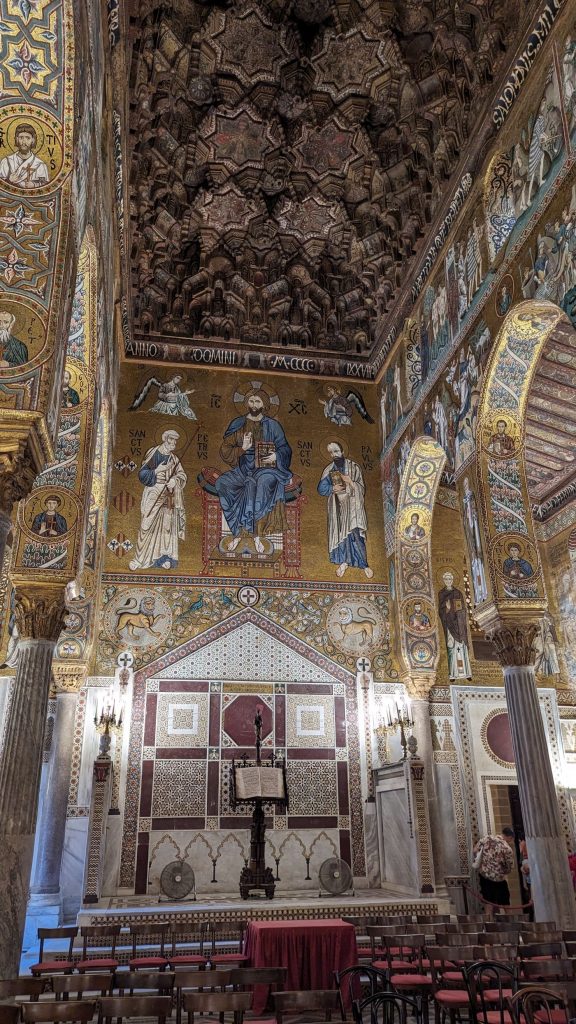
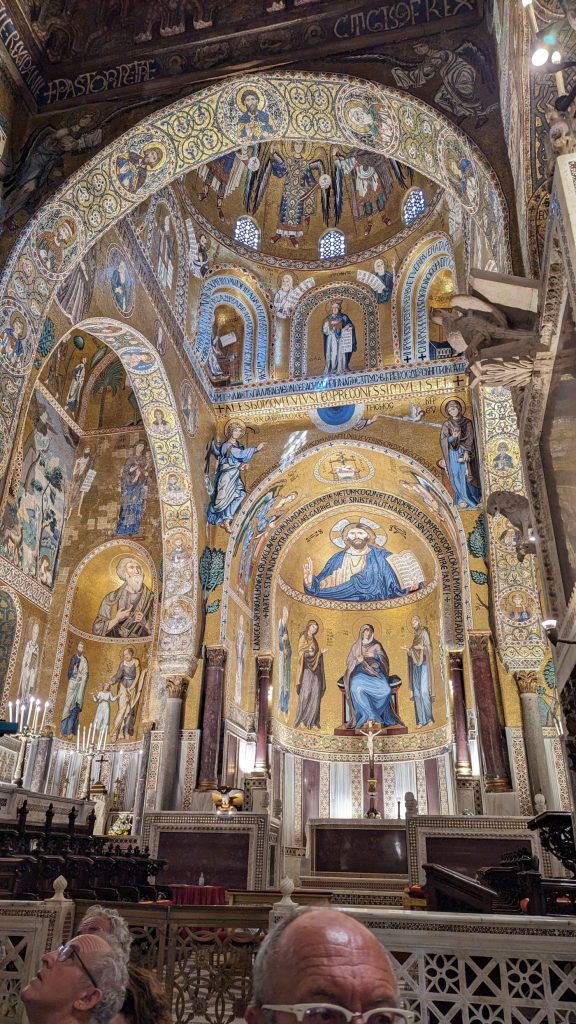
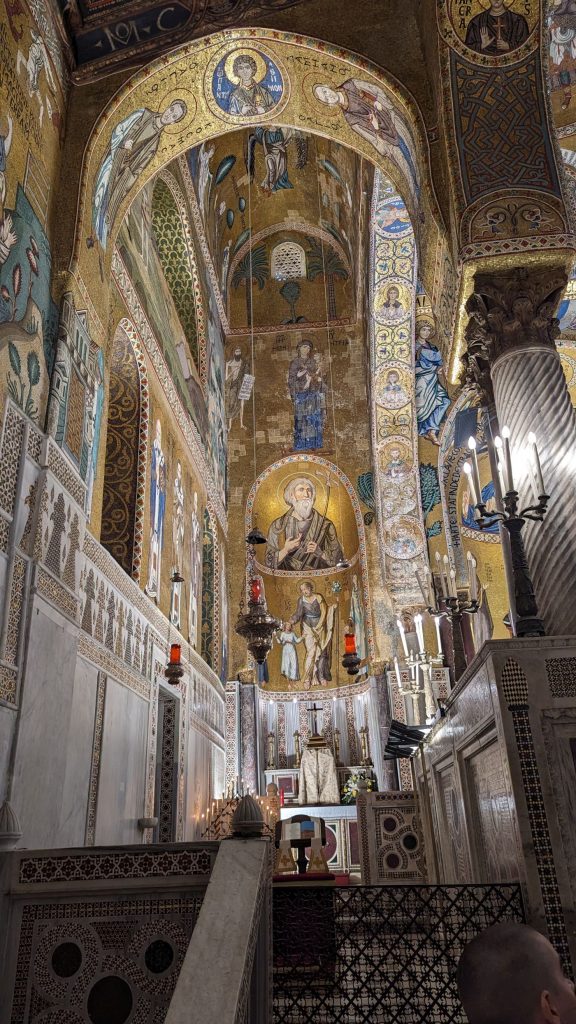
Next on the agenda was the Church of St. John of the Hermits (a.k.a. San Giovanni degli Eremiti).
As far as I could tell, one can only visit the grounds and see the church from the outside. That was fine because it was all quite pretty. I felt a lovely sense of calm the entire time I was there. The church is notable for its brilliant red domes, which show clearly the persistence of Arab influences in Sicily at the time of its reconstruction in the 12th century, the Arab-Norman culture.
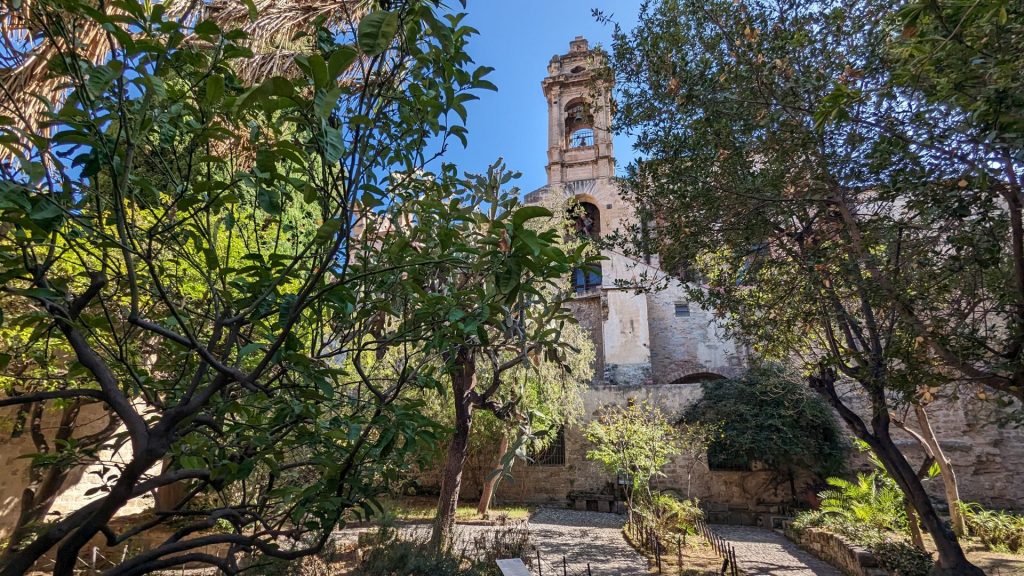
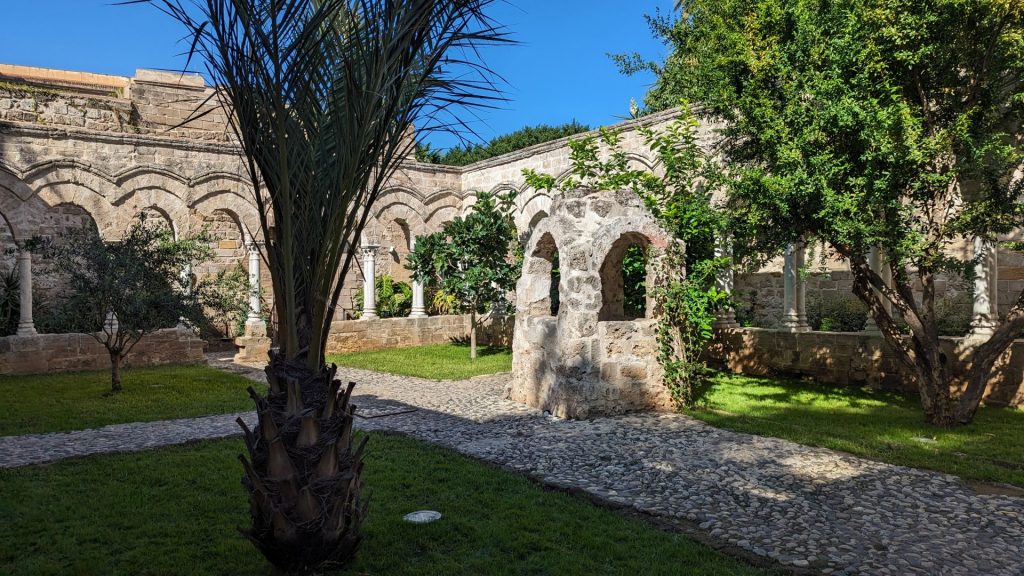
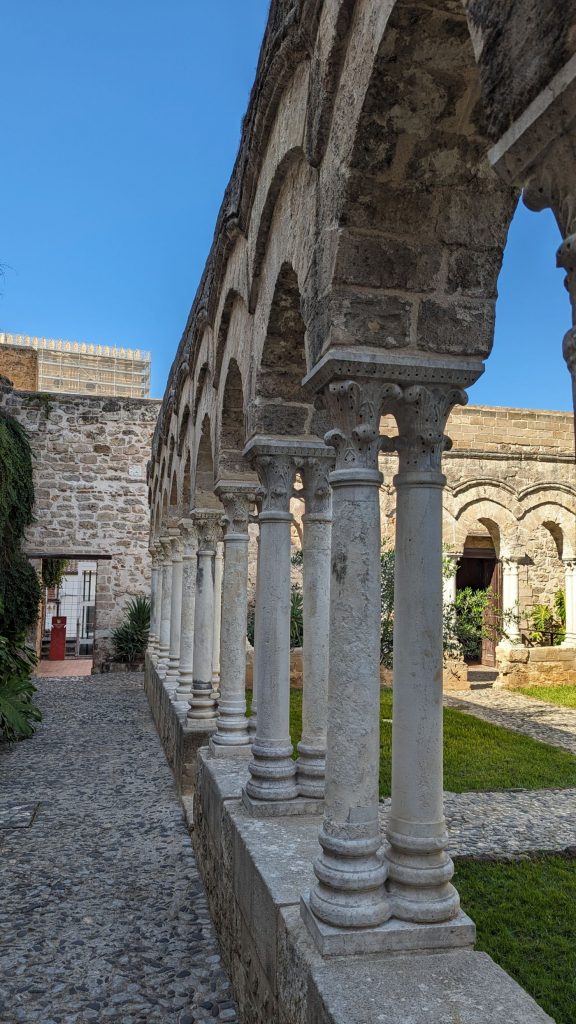
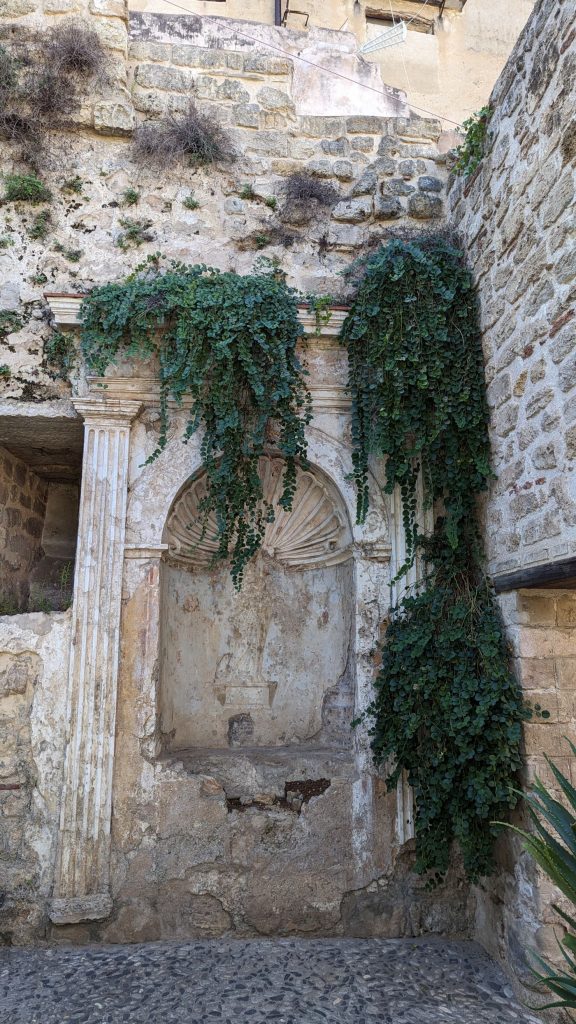
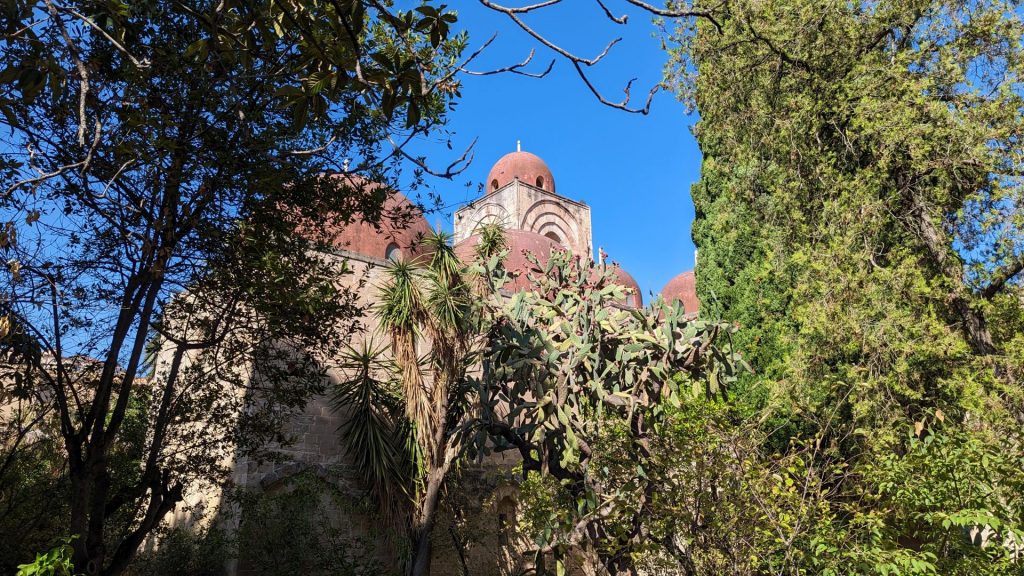
I was quite looking forward to the next stop: the catacombs. I admit to breaking the “no photography” rule.
Some info from Wikipedia (supported by other sources):
Palermo’s Capuchin monastery outgrew its original cemetery in the 16th century and monks began to excavate crypts below it. In 1599 they mummified one of their number, the recently-deceased brother Silvestro of Gubbio, and placed him in the catacombs.
Bodies were dehydrated on racks of ceramic pipes in the catacombs and sometimes later washed with vinegar. Some bodies were embalmed and others were enclosed in sealed glass cabinets. Friars were preserved with their everyday clothing and sometimes with ropes they had worn in penance.
Initially the catacombs were intended only for deceased friars. However, in later centuries it became a status symbol to be entombed in the Capuchin catacombs. In their wills, local luminaries would ask to be preserved in certain clothes, or even have their clothes changed at regular intervals. Priests wore their clerical vestments, while others were clothed according to contemporary fashion. Relatives would visit to pray for the deceased and to maintain the body in presentable condition.
The catacombs were maintained through donations from the relatives of the deceased. Each new body was placed in a temporary niche and later placed into a more permanent location. So long as contributions continued, the body remained in its proper place but if relatives stopped sending money, the body was put aside on a shelf until they resumed payments.
The catacombs contain about 8,000 corpses and 1,252 mummies (as of a census made by EURAC in 2011) that line the walls. The halls are divided by category: men, women, virgins, children, priests, monks, and professionals. Some bodies are better preserved than others. Some are set in poses; for example, two children are sitting together in a rocking chair. The coffins were accessible to the families of the deceased so that on certain days the family, including the deceased, could join their hands in prayer.
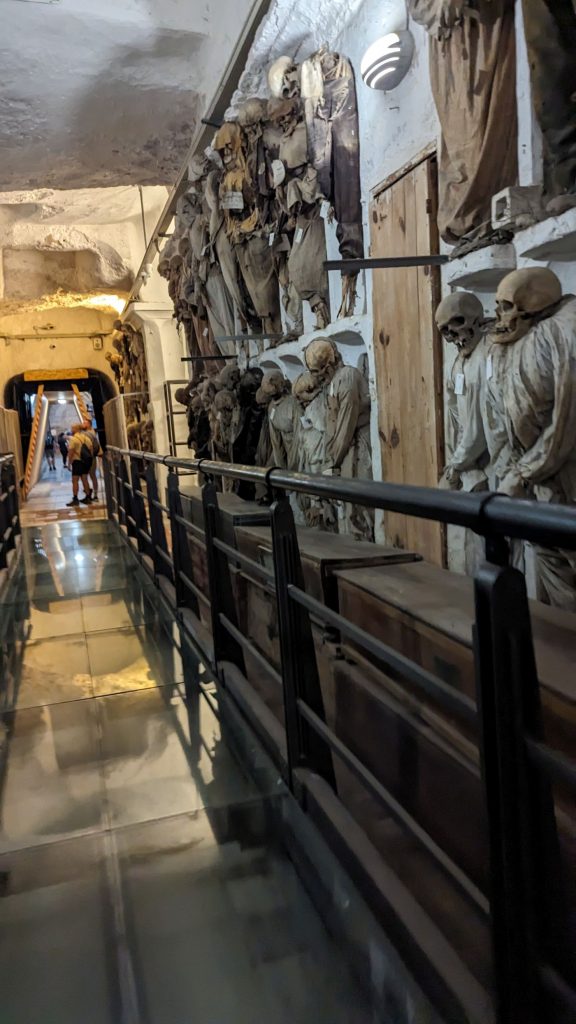
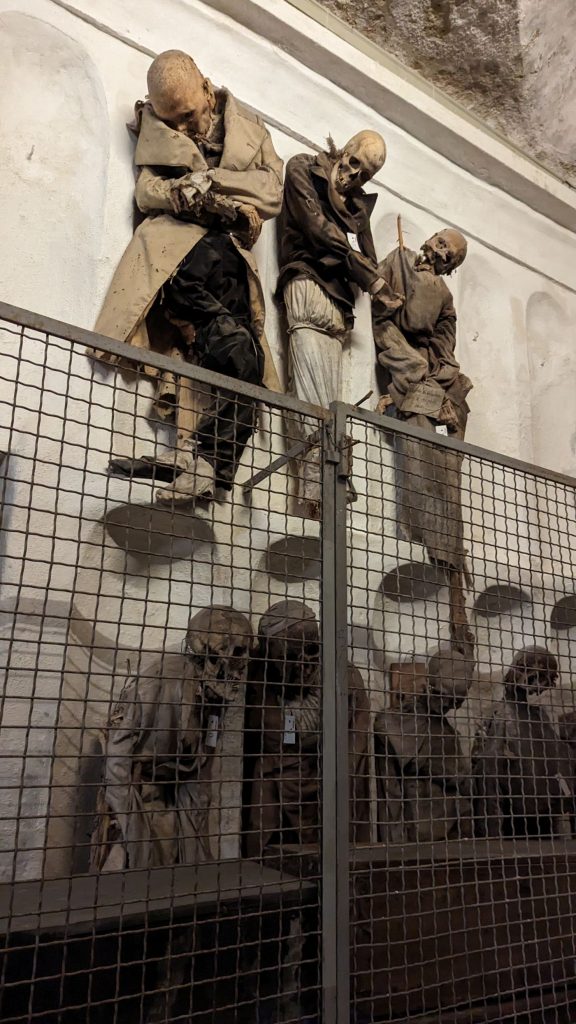
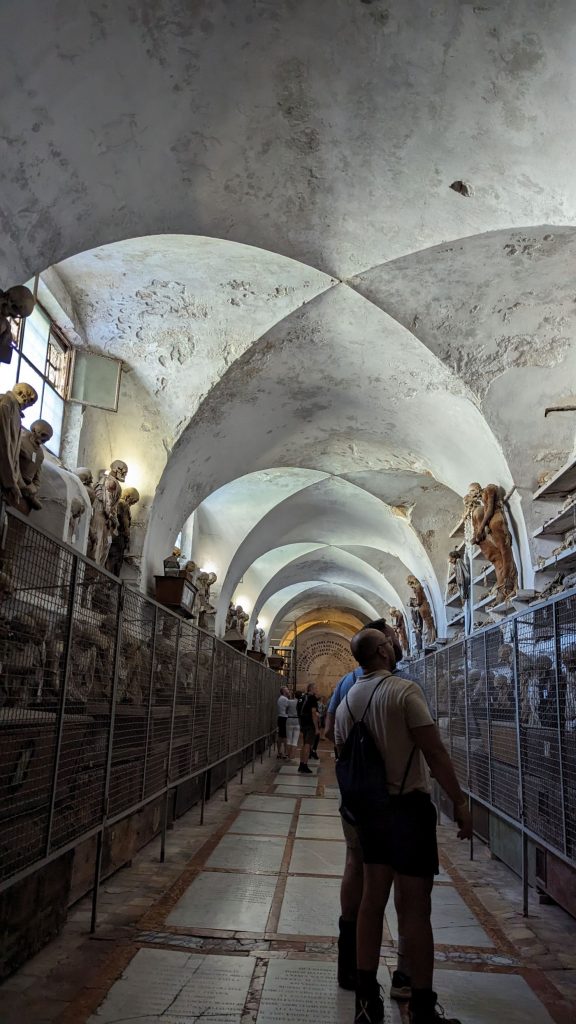
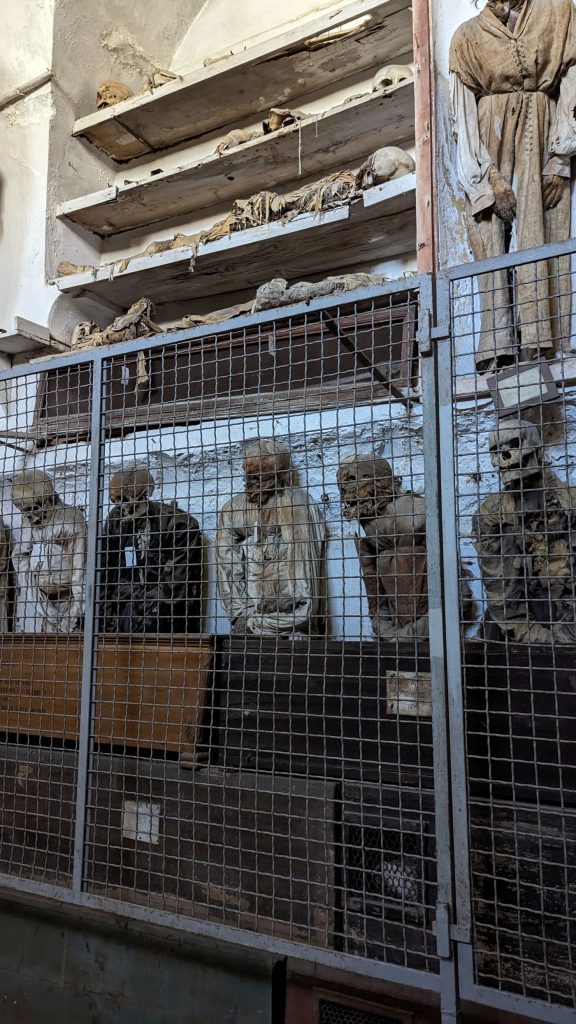
One of my most vivid memories is of a female whose hat had a bright red flower on it. it was the only bright color I saw.
We are getting close to the end of my sightseeing day. My next stop was the Church of San Giuseppe dei Padri Teatini (a.k.a. Church of Saint Joseph of the Theatines). The church was built at the beginning of the 17th century by Giacomo Besio, a Genoese member of the Theatine order. It has a majestic though simple façade. In the center niche is housed a statue of San Gaetano, founder of the order. Another striking feature is the large dome with a blue and yellow majolica covering. (The dome can be seen in the picture of the fountain posted later in today’s post.)
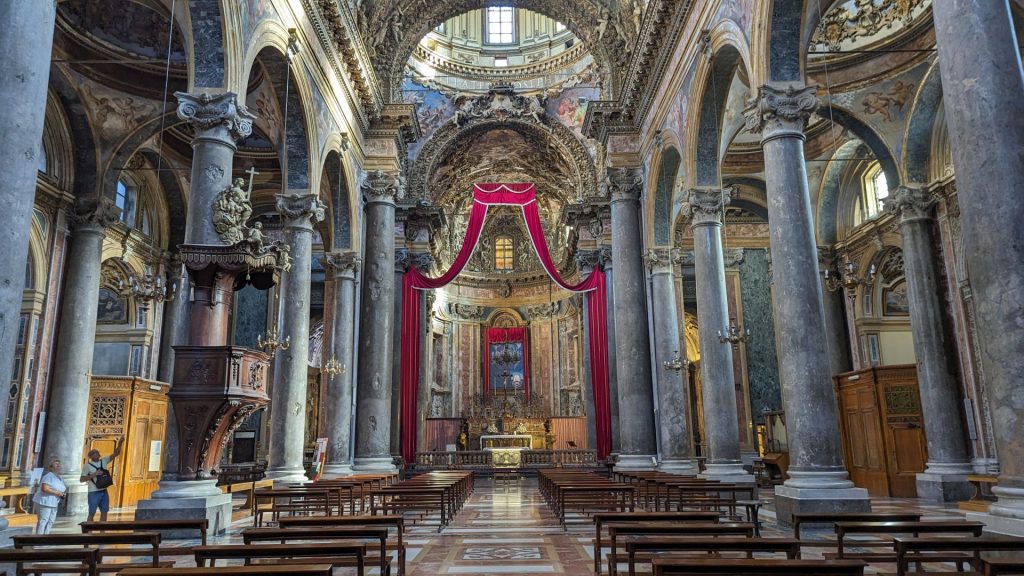
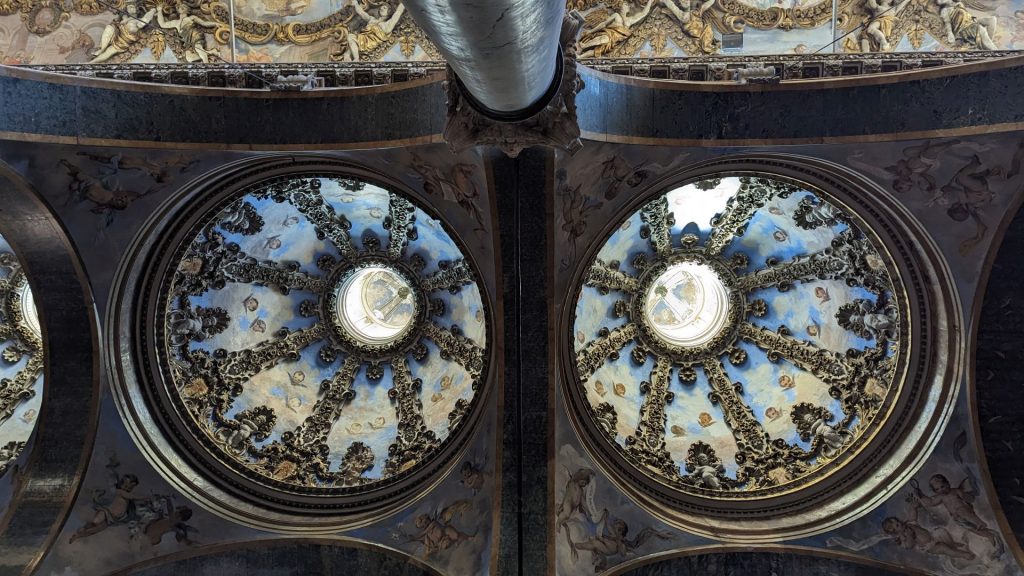
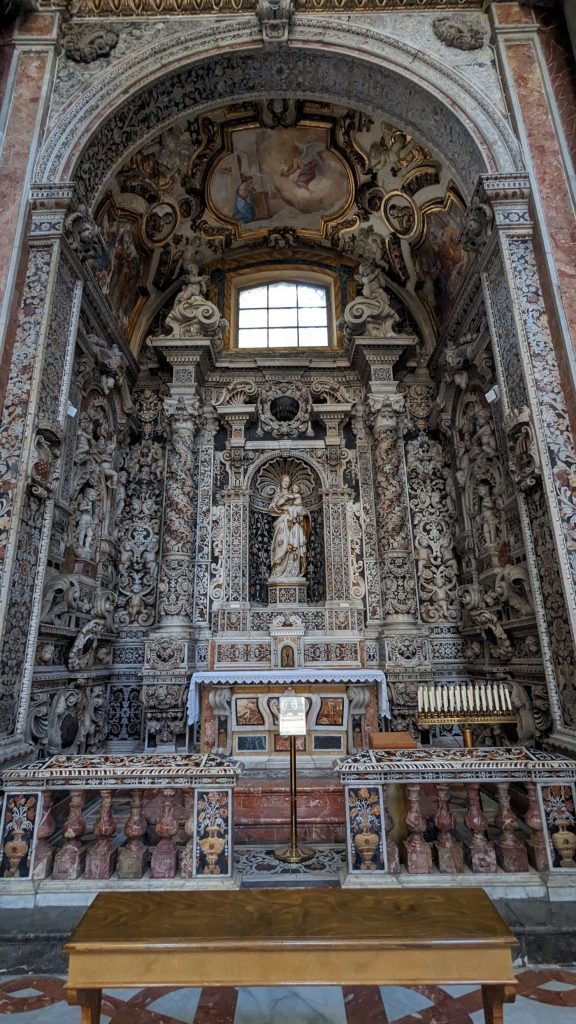
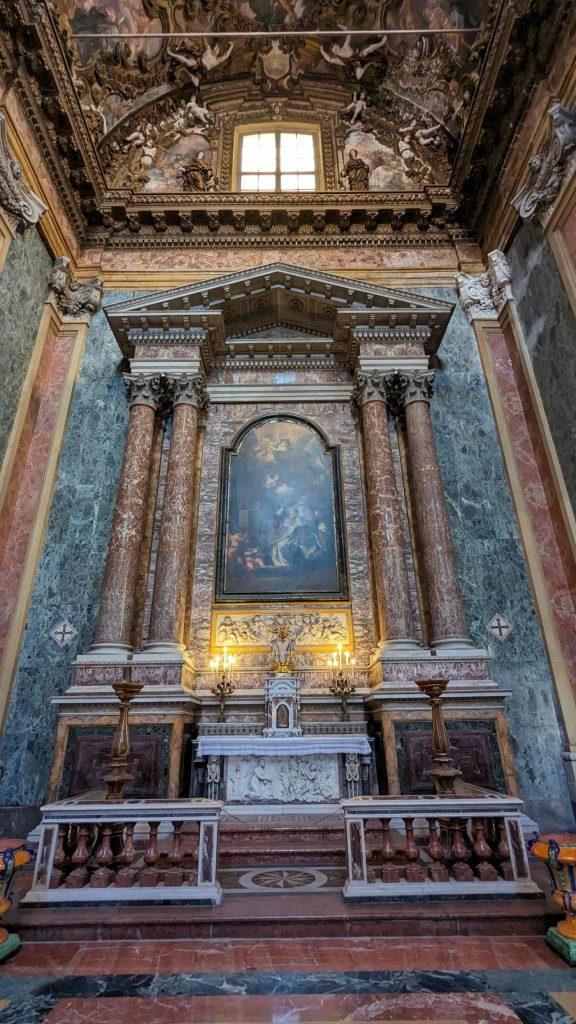
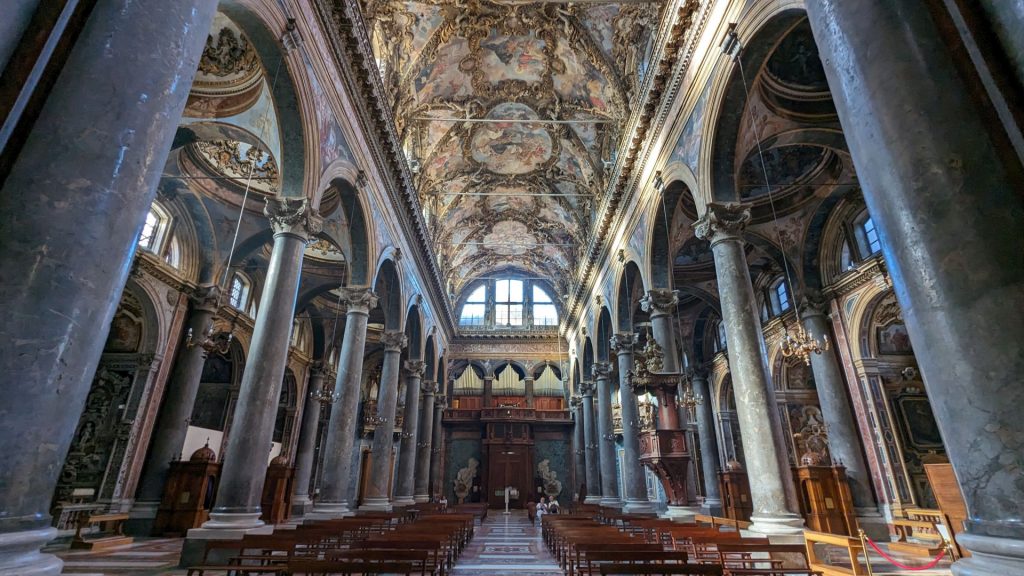
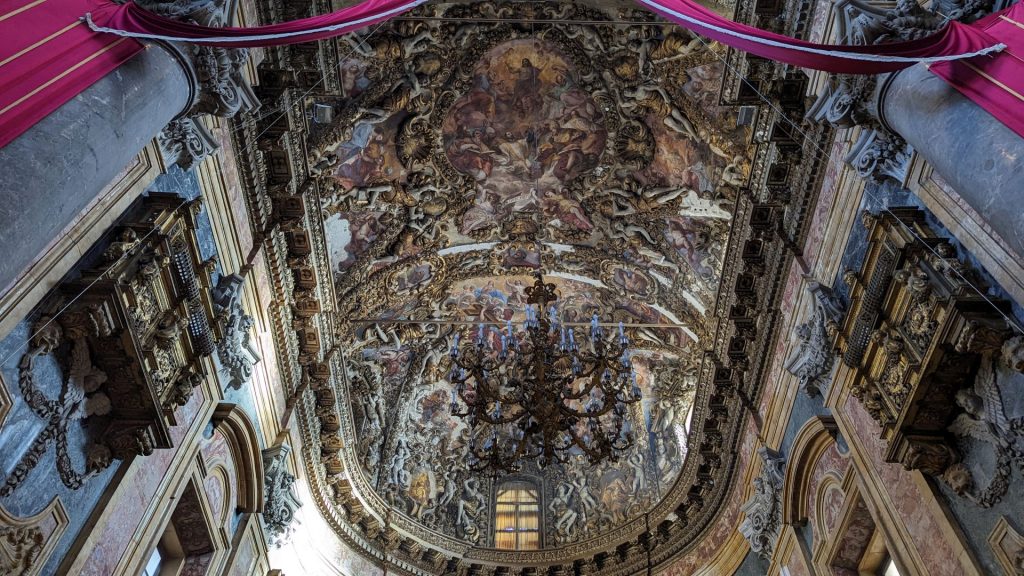
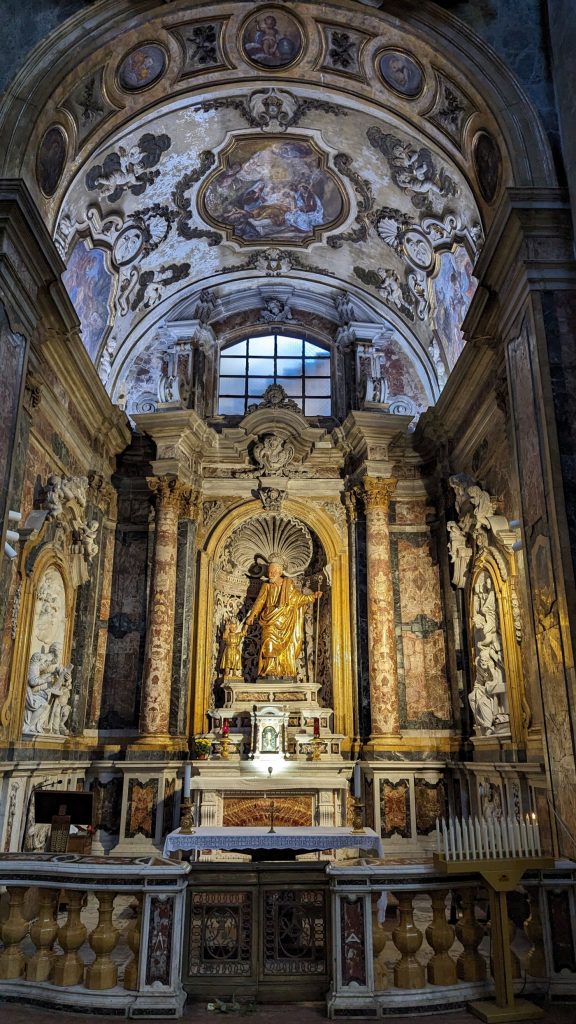
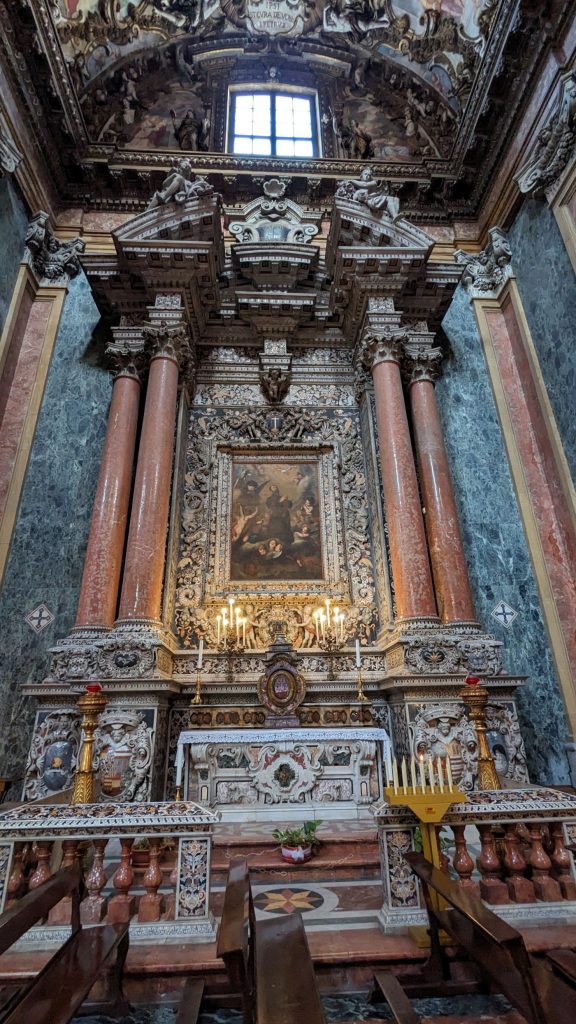
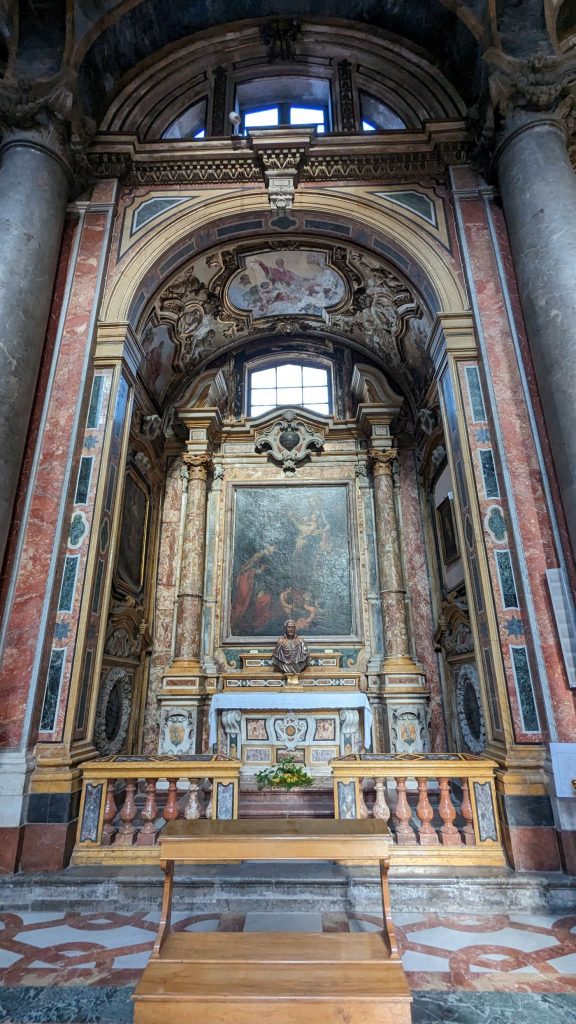
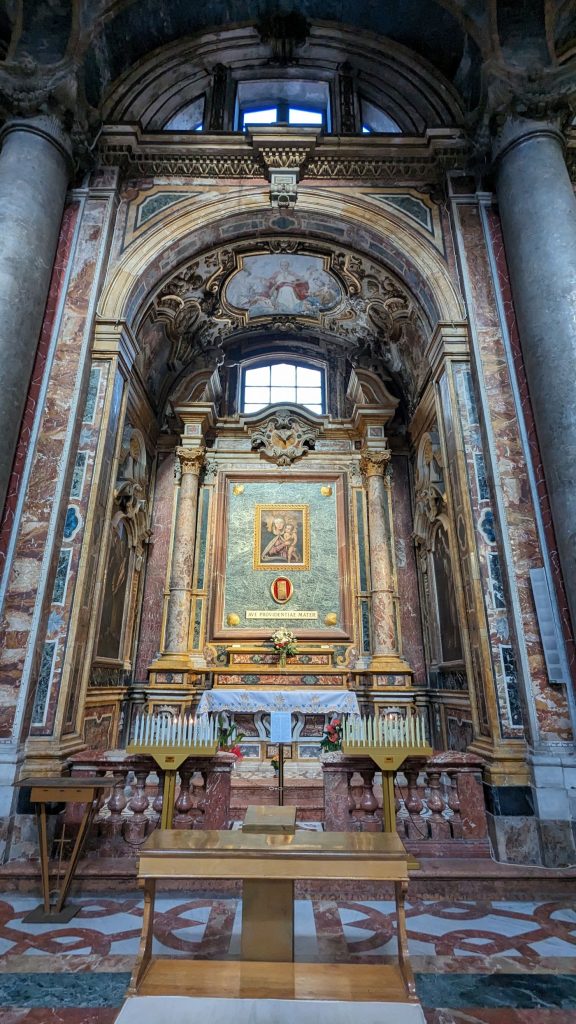
The following picture is of the Fontana Pretoria. The Praetorian Fountain was created in 1554 by the Tuscan sculptor Francesco Camilliani as a decoration for a Florentine villa. It was subsequently purchased by the Palermo Senate for 20 or 30.000 scudi, and reached Palermo in 644 pieces and then reconstructed differently from the original design.
The fountain has an elliptical structure with concentric basins arranged on three levels; stairs and statues alternate according to a classical, symmetrical pattern.
The four basins of the first level, with statuary groups of lying figures, represent Palermo’s rivers: Oreto, Papireto, Gabriele, and Maredolce; the faces of the Genius of Palermo, St. Rosalia, and the Praetorian Eagle are all depicted in the fencing. A rich sculptural repertoire is representing mythological deities, monsters, animals, dolphins, harpies, and mermaids.
The open nakedness of the figures displayed did not fail to upset the minds of citizens, who renamed this site “Piazza della Vergogna” (“Square of Shame”). The gate, designed by Giovan Battista Filippo Basile, was placed here in 1858.
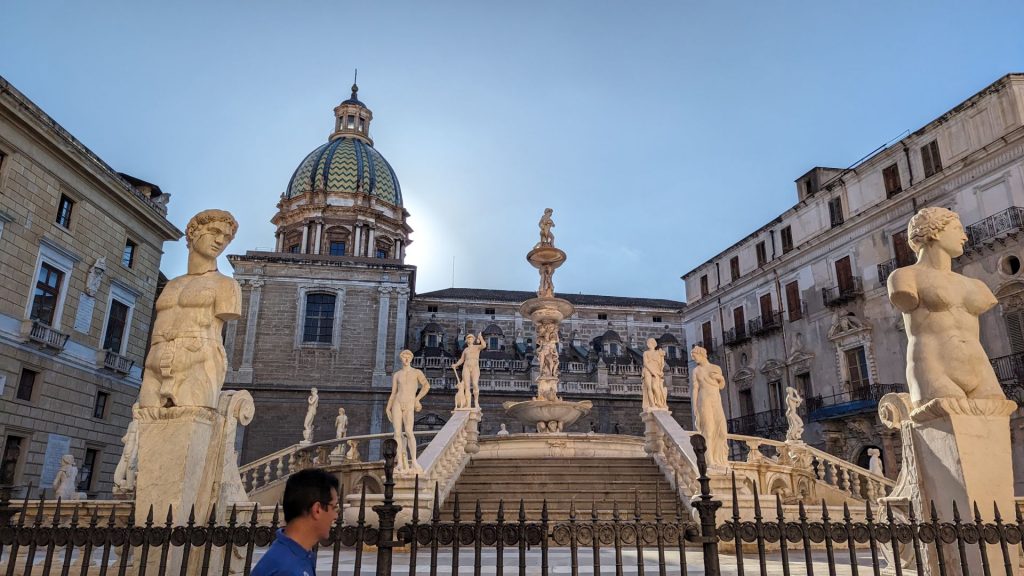
My last stop of the day was to the Church of Saint Catherine of Alexandria (a.k.a. Chiesa of Santa Casterina d’Alessandra).
The Church of Saint-Catherine was built at the end of the 16th century and once formed part of a Dominican convent. Typical of Italian churches built at this time, it incorporates Renaissance, Baroque and Rococo elements and almost every surface is covered with paintings, cherubs, decorative marble and color. Most of the decoration was added to the during the 17th and 18th centuries, although many of the artists’ names are unknown.
As you can tell from the pictures, I enjoyed the cherubs and other marble decorations.
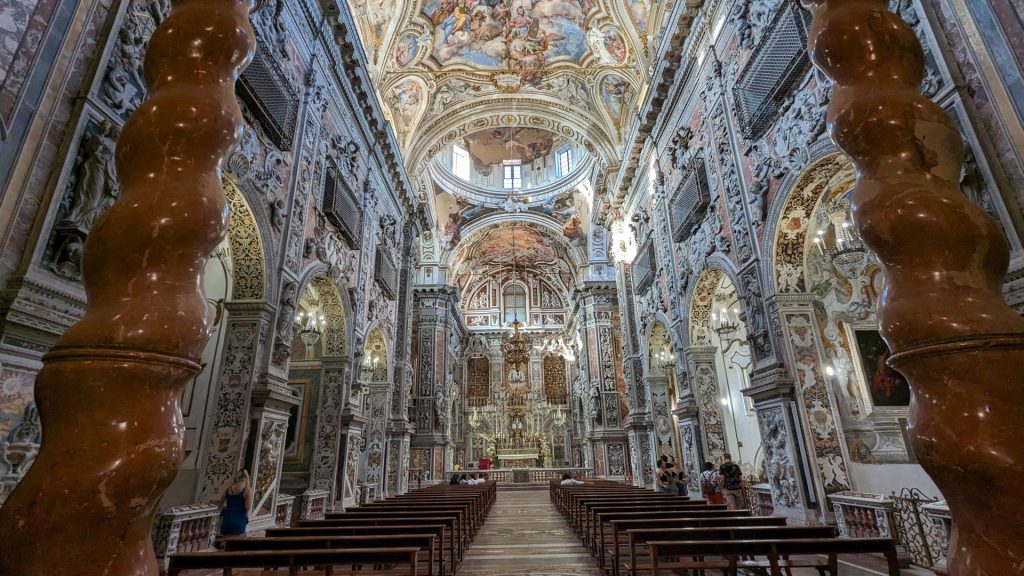
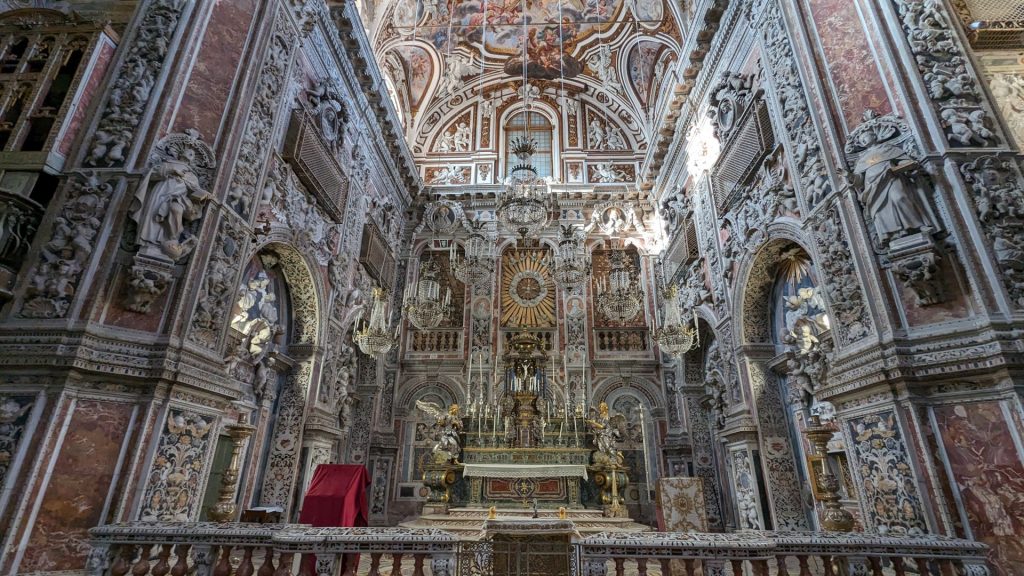
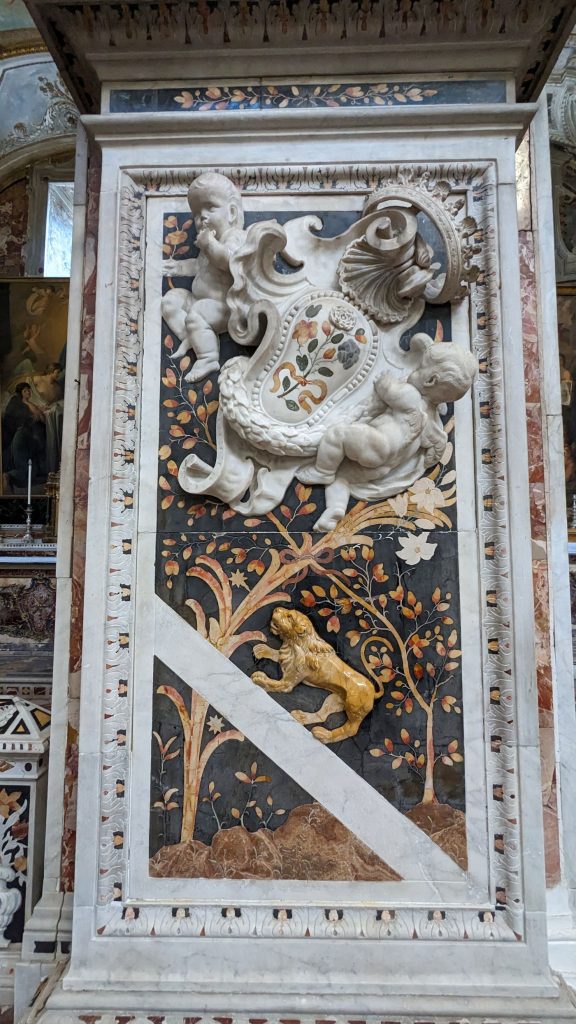
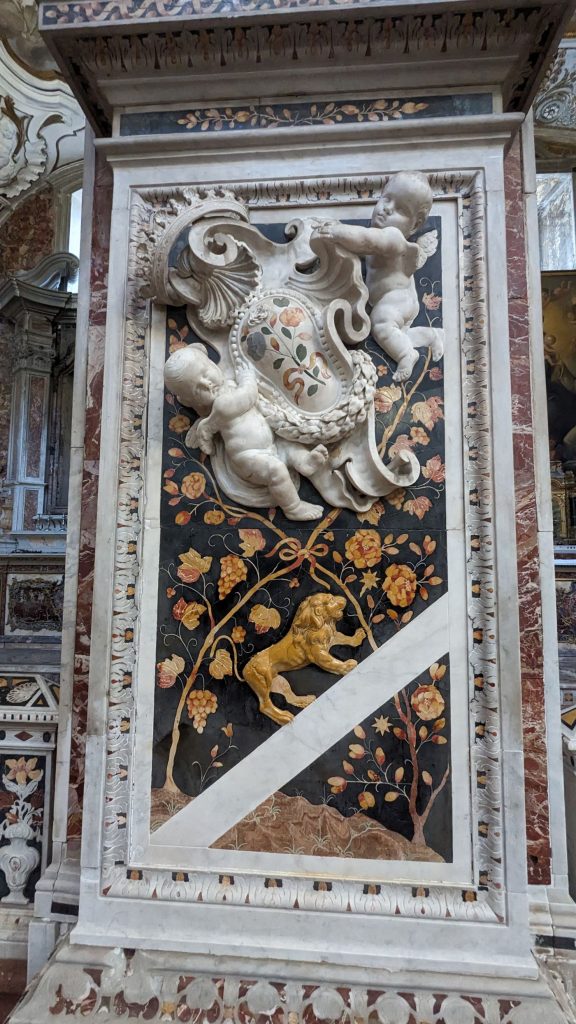
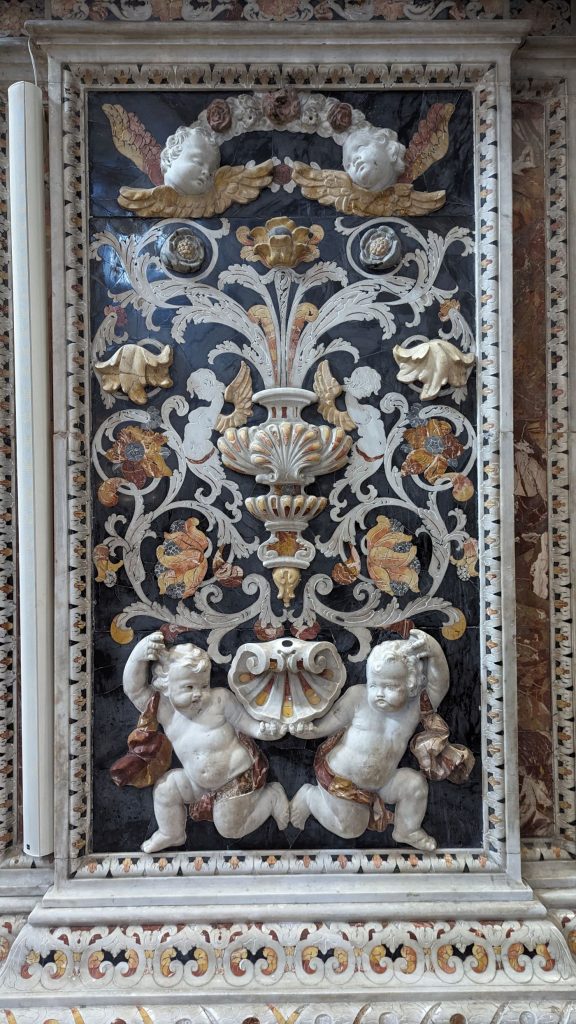
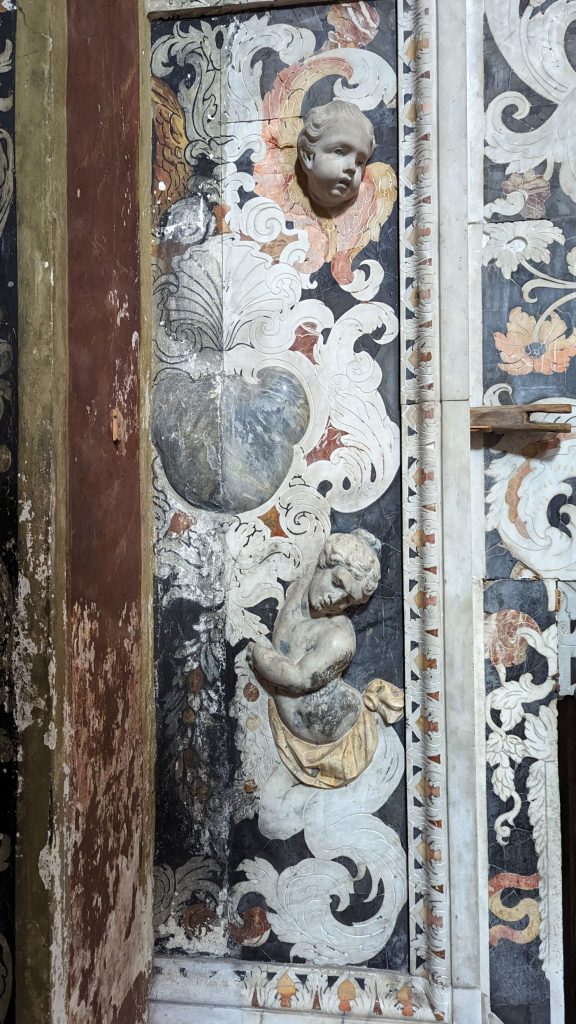
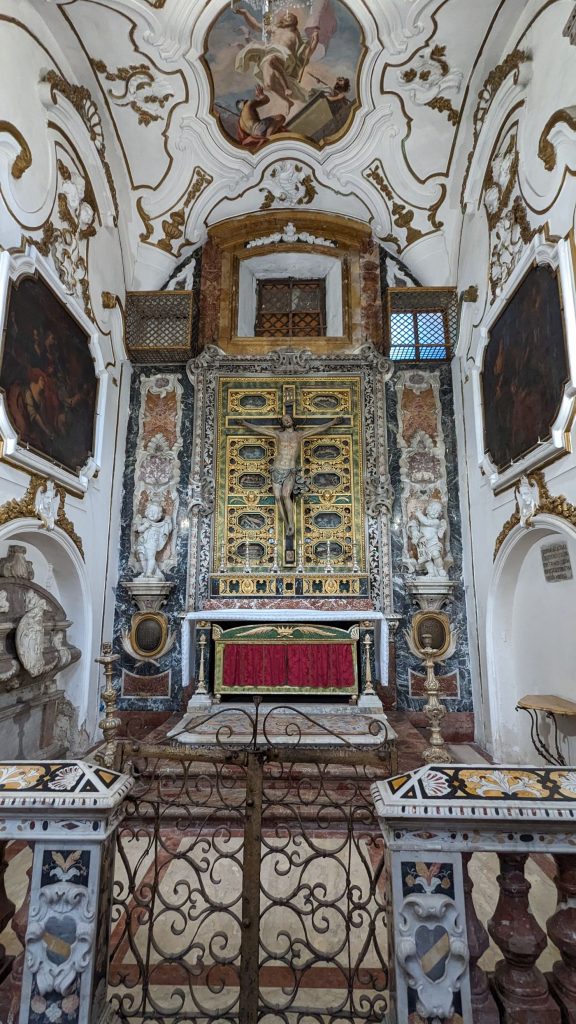
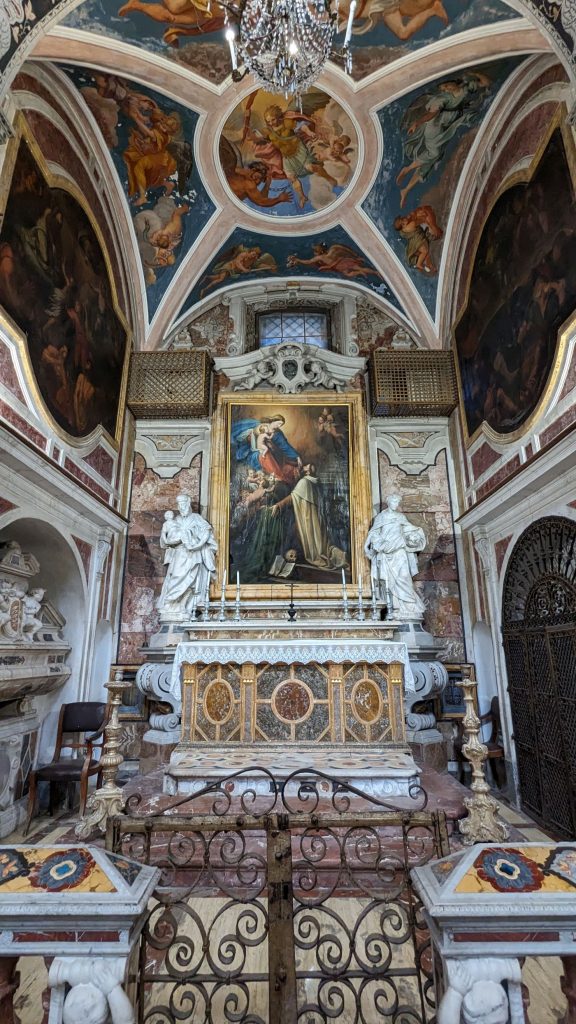
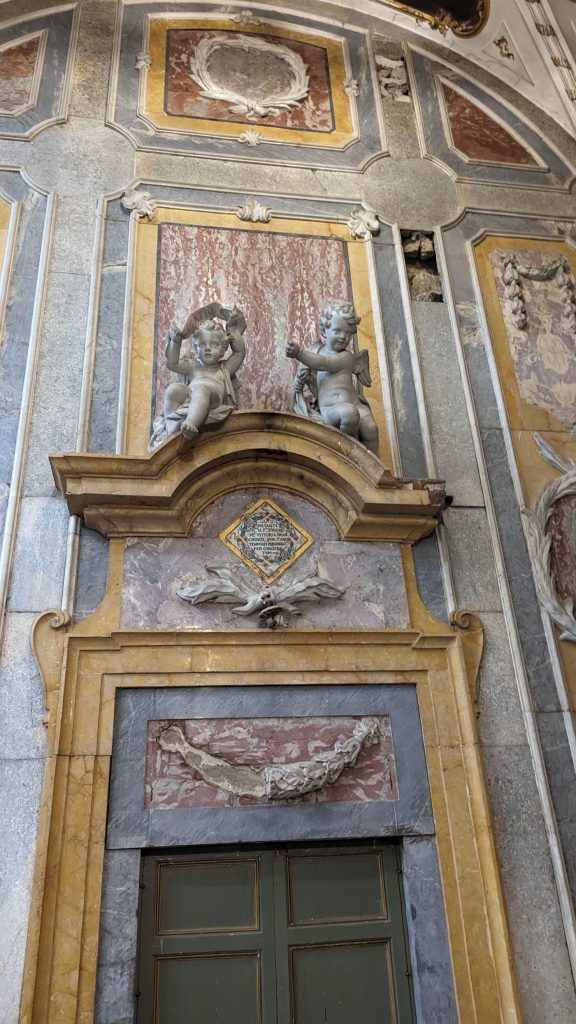
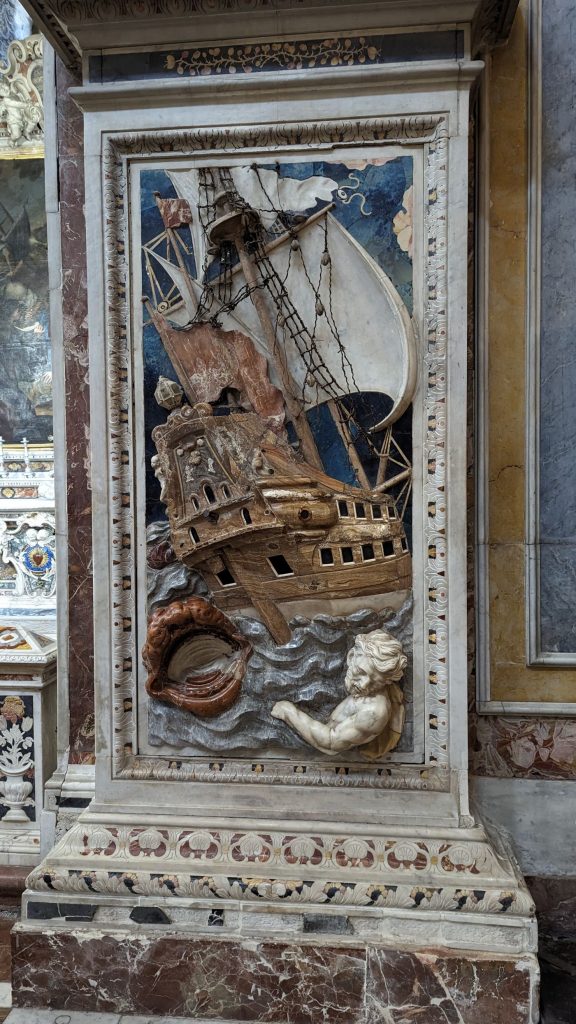
I felt well enough by now to have a glass of wine and some food.
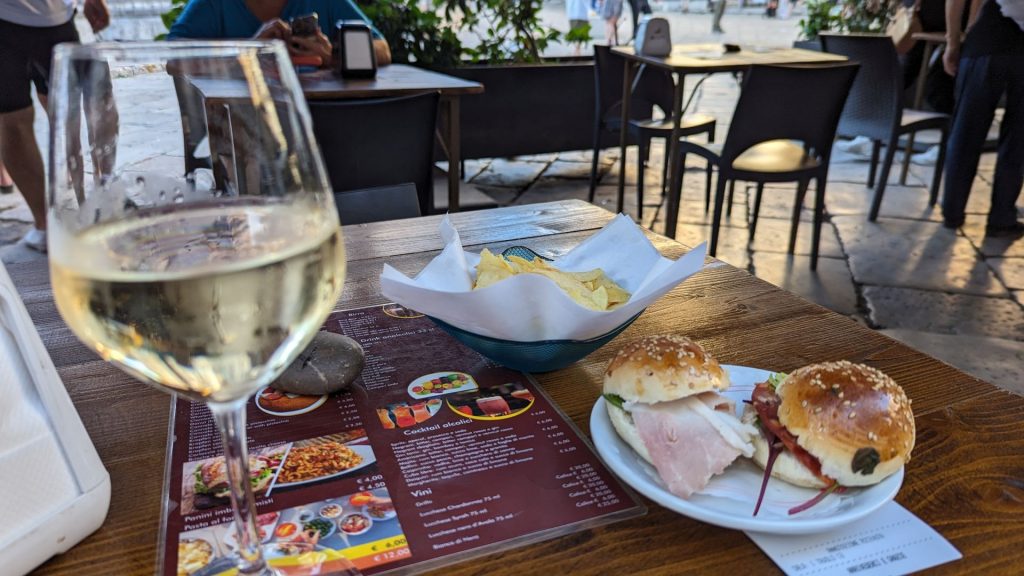
We left for Tunisia the next day. Our next post will introduce you to the marina where we will be staying until mid-February.

I was in Palermo October 2-5 before doing a tour around Sicily. I was there for two weeks and then on to the mainland for another week. It would have been fun to run into you guys.